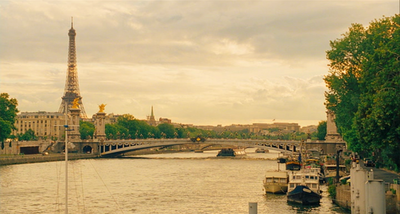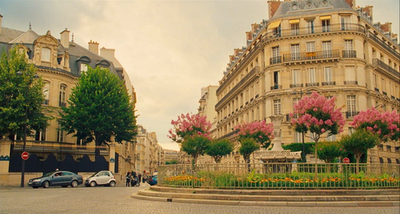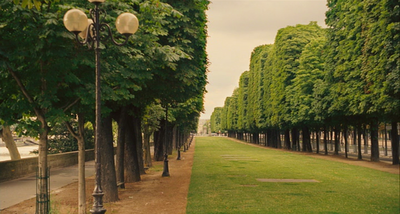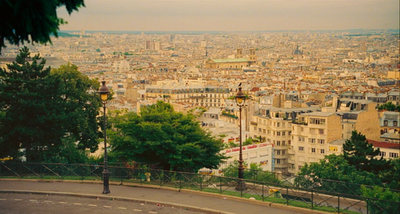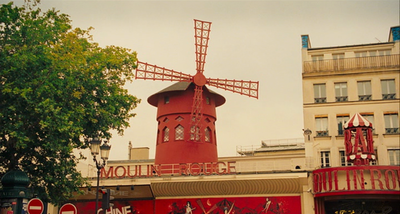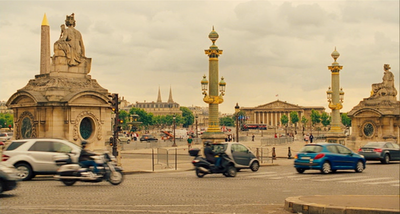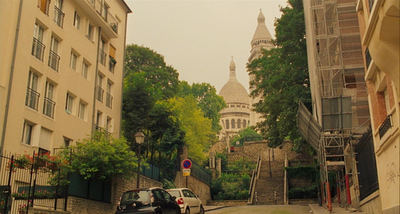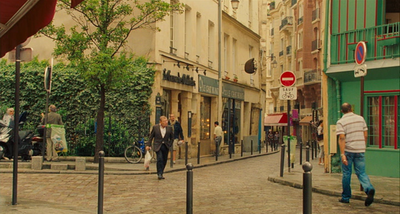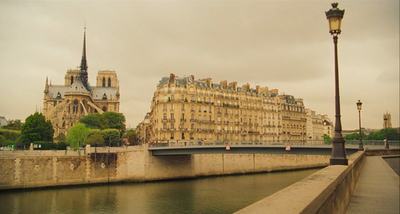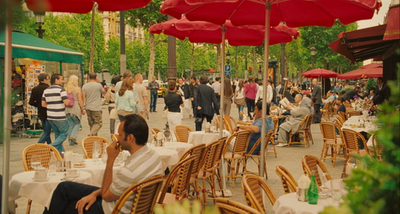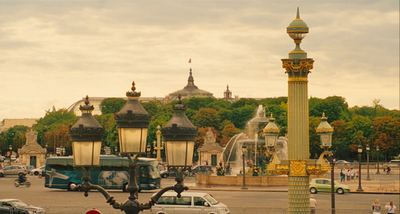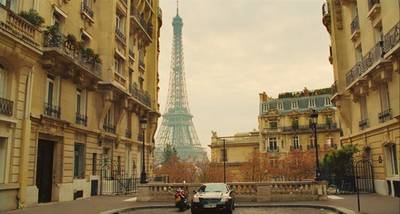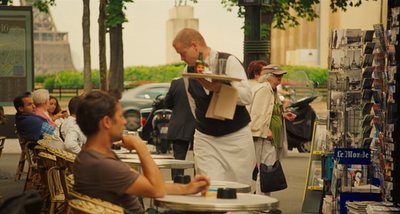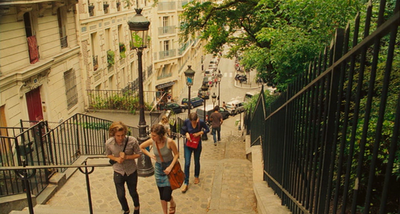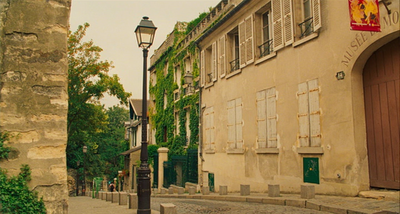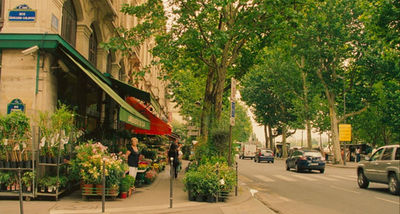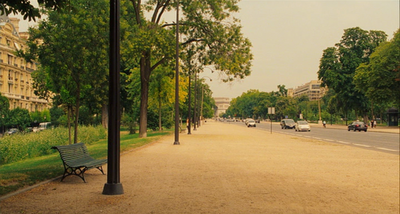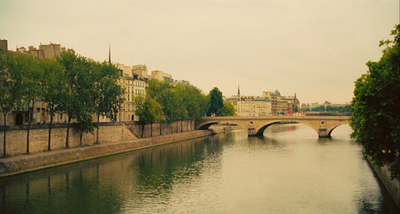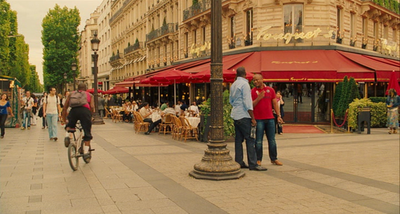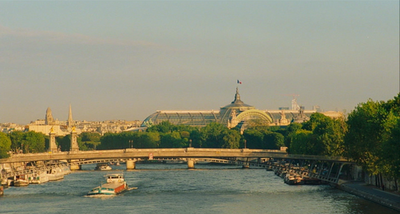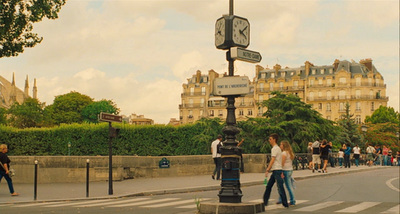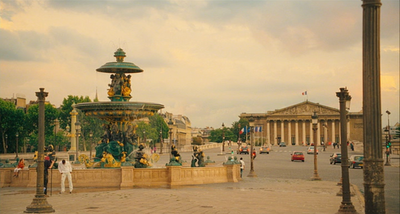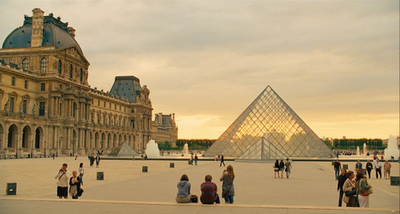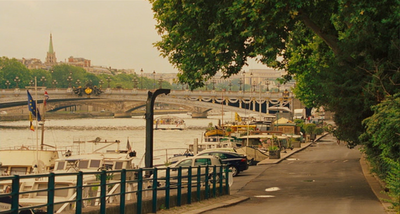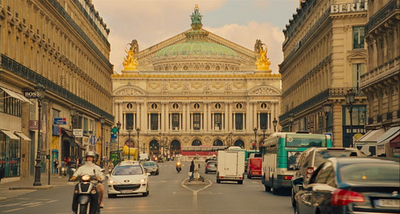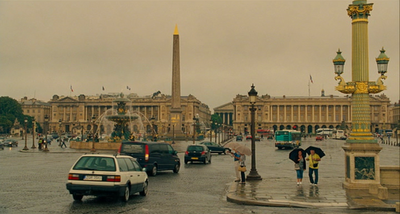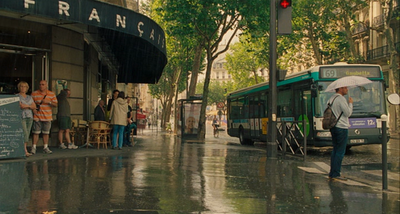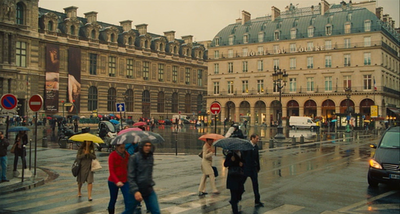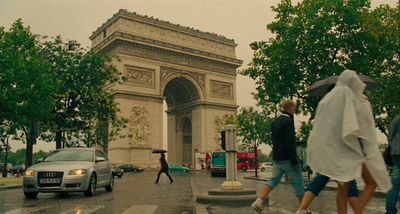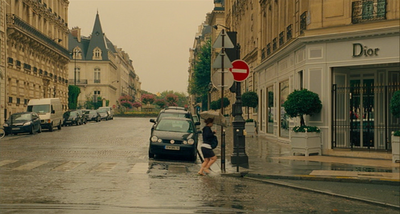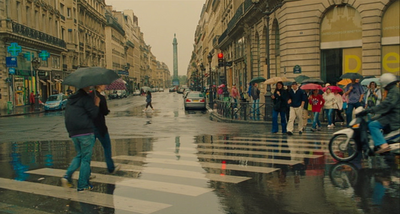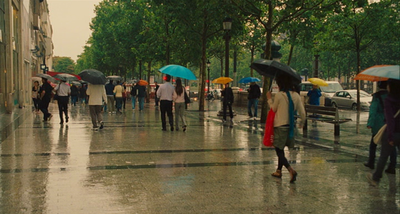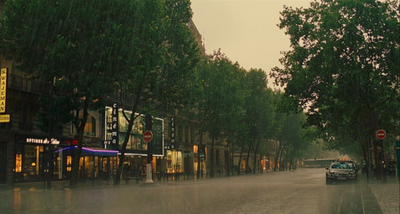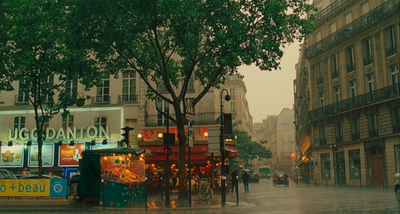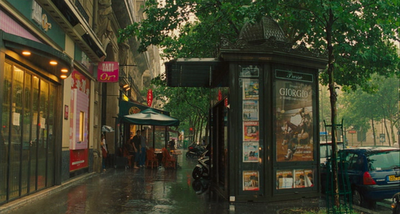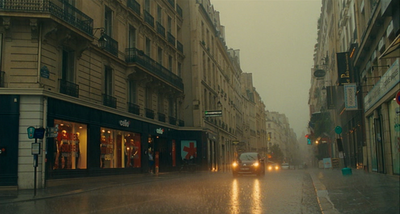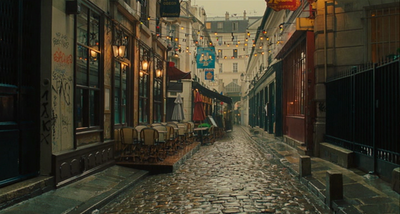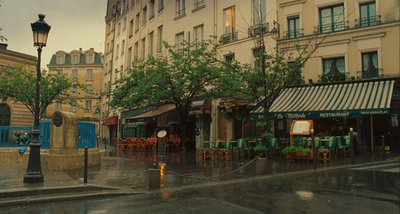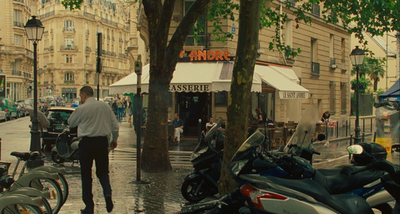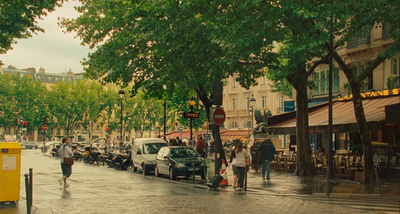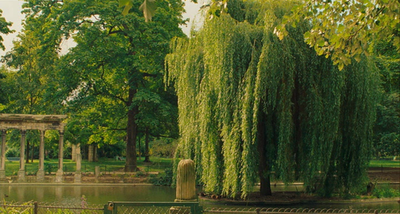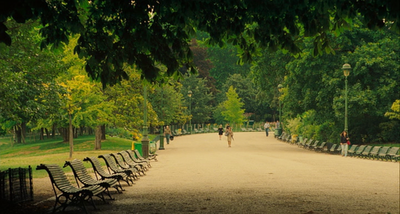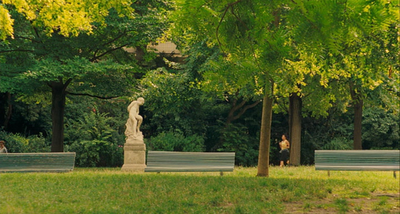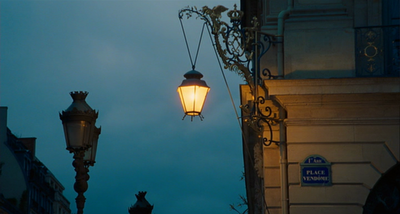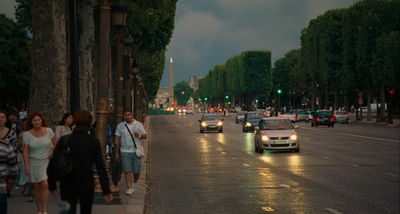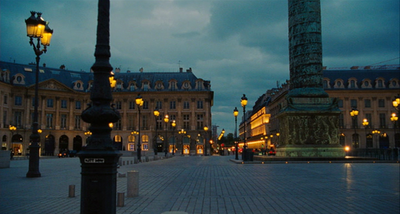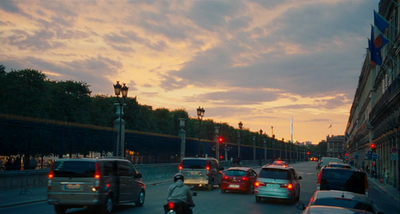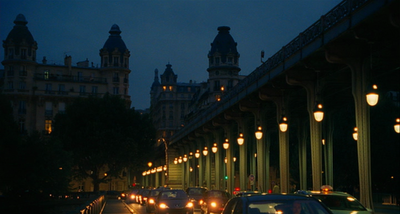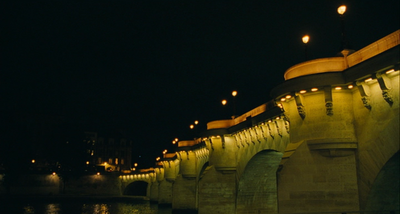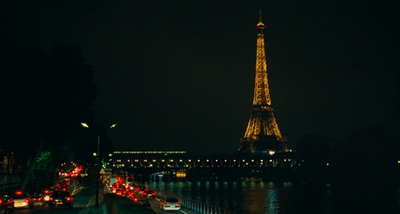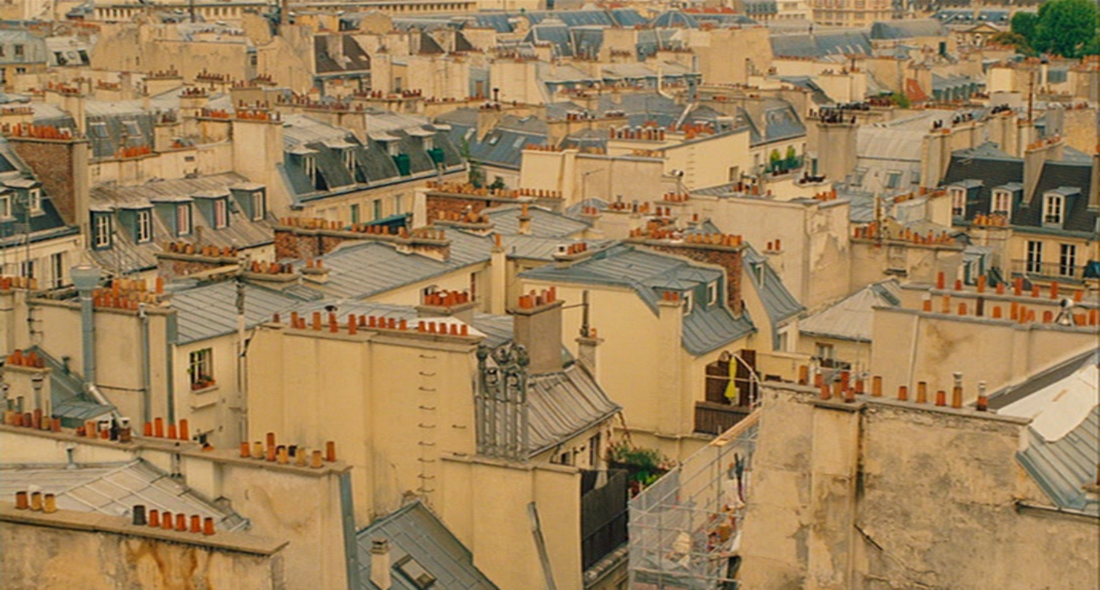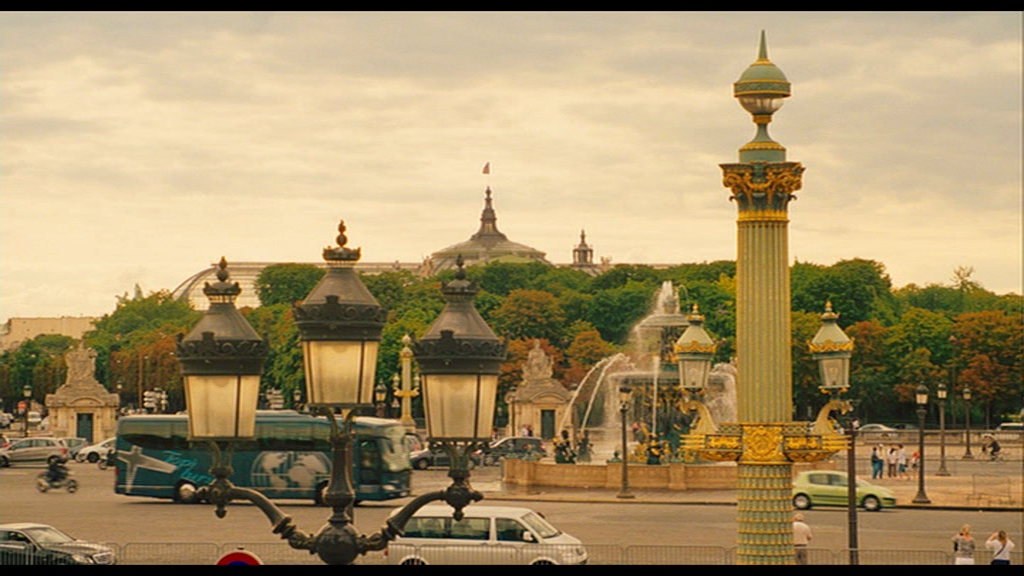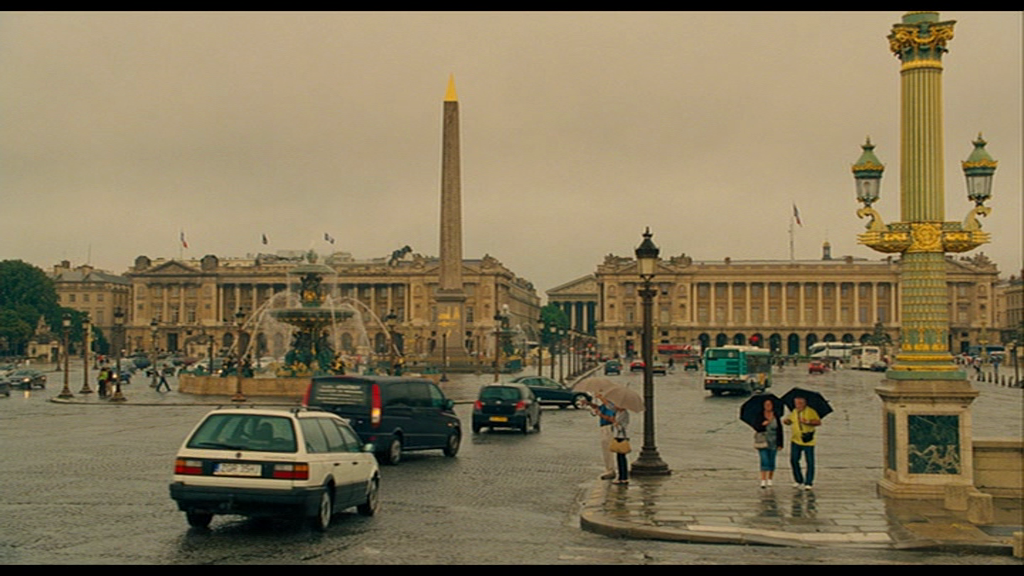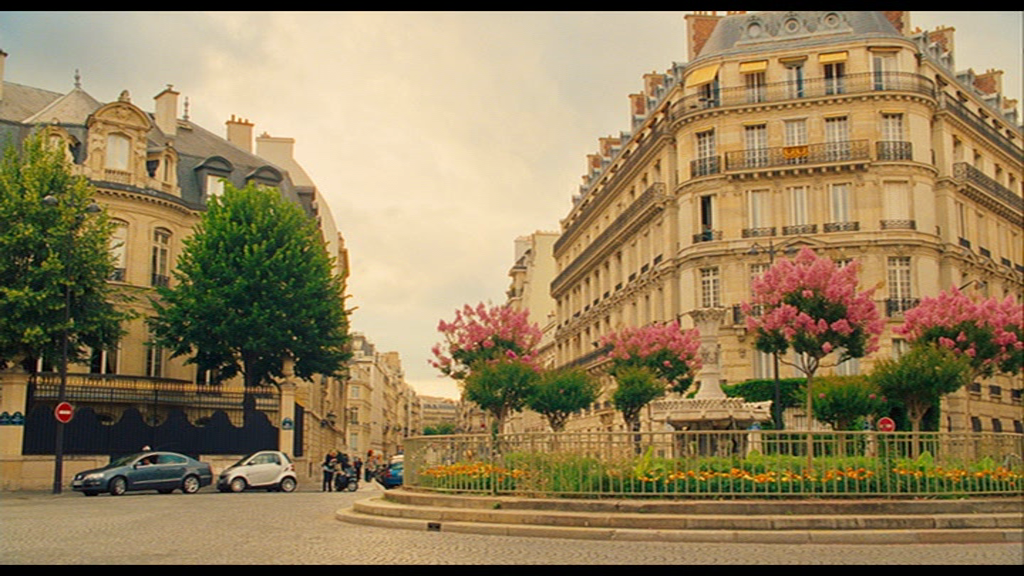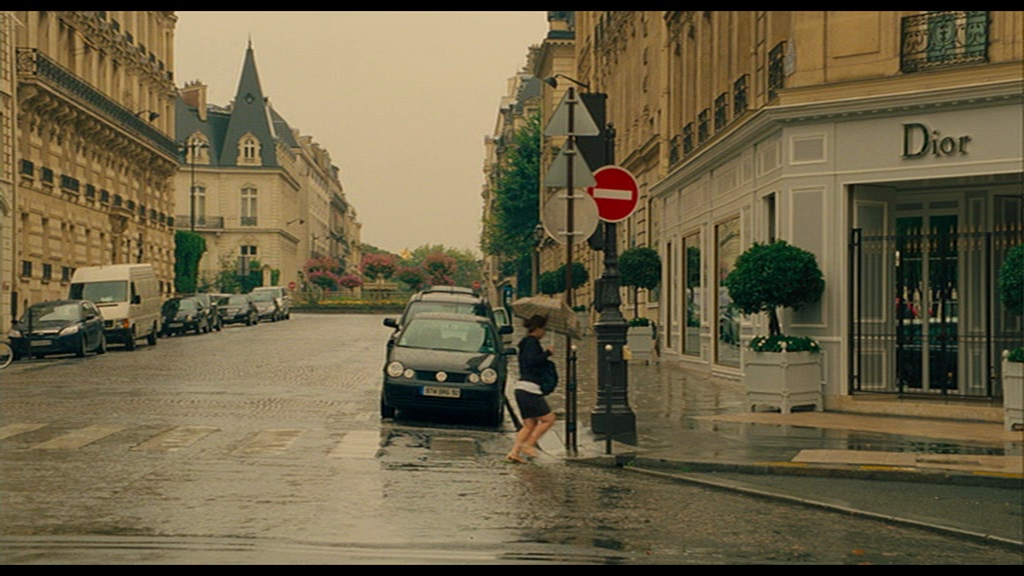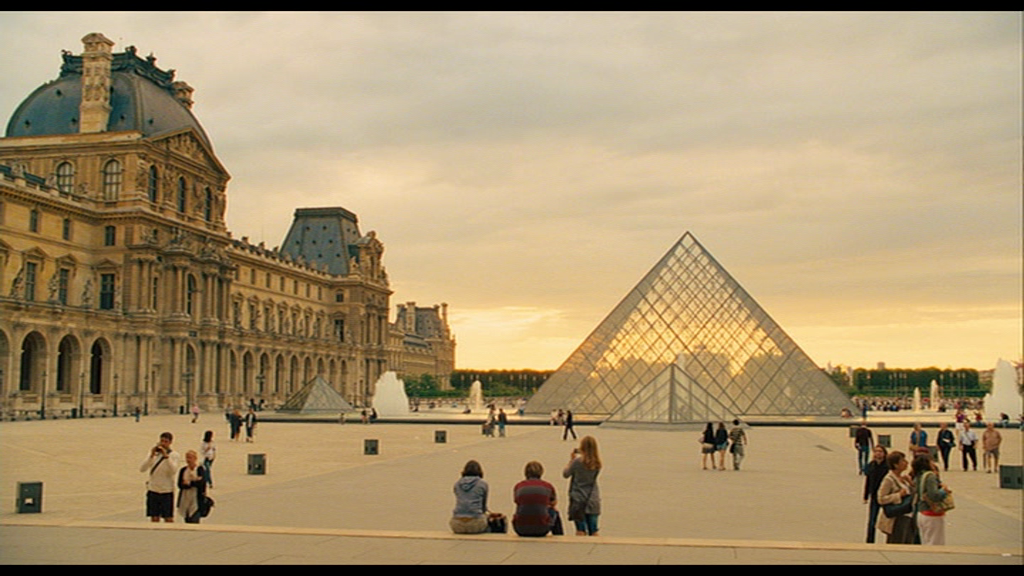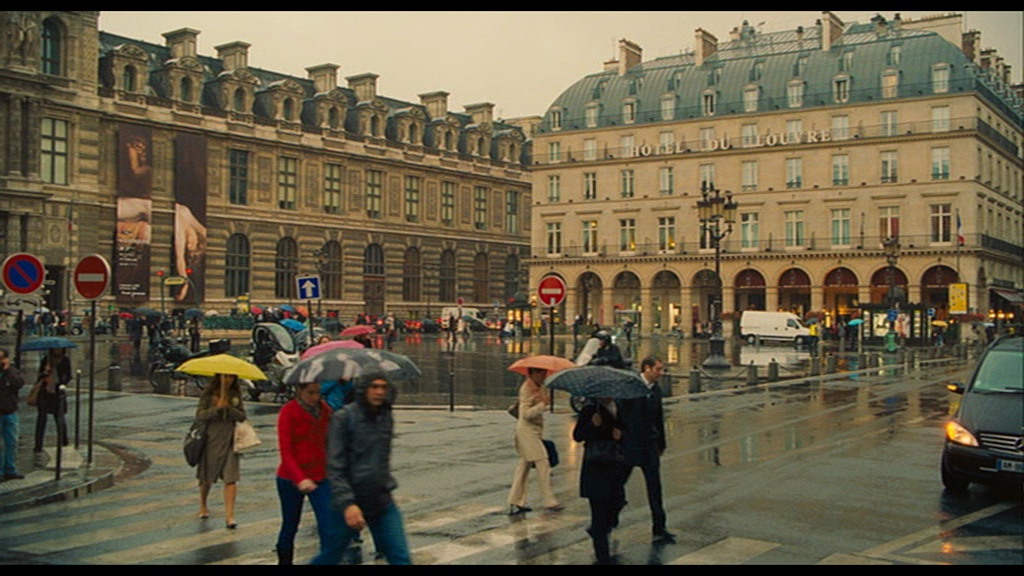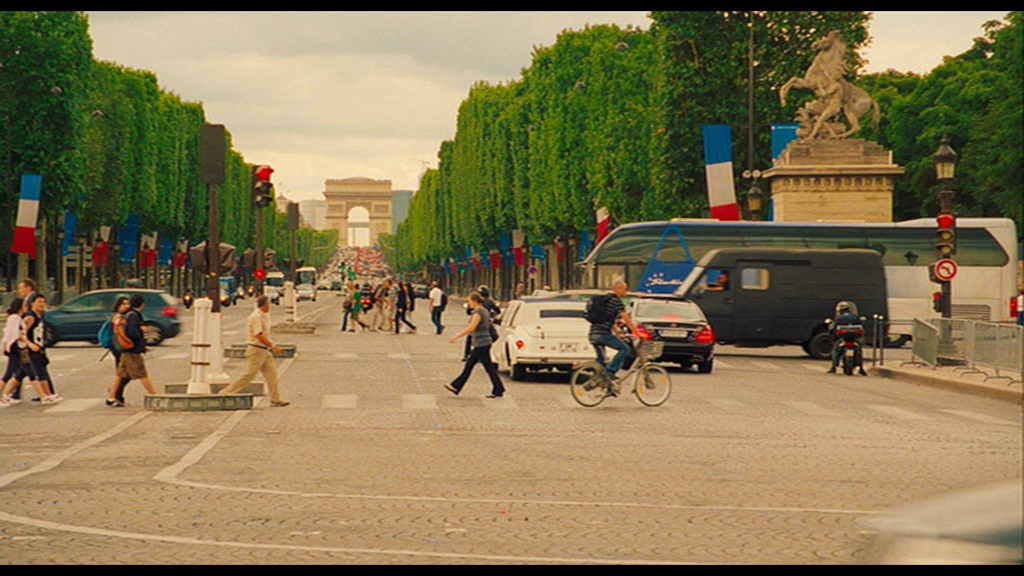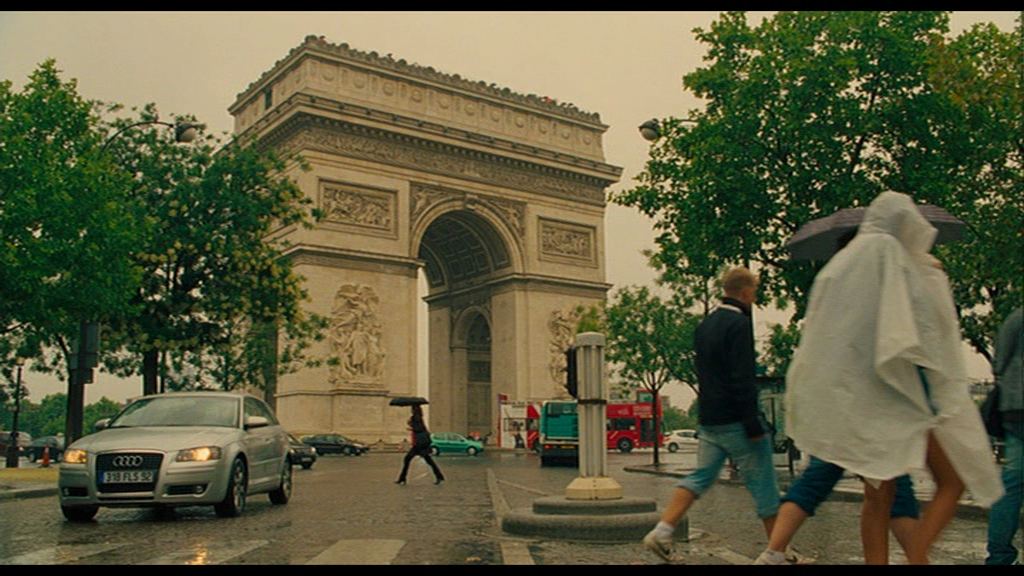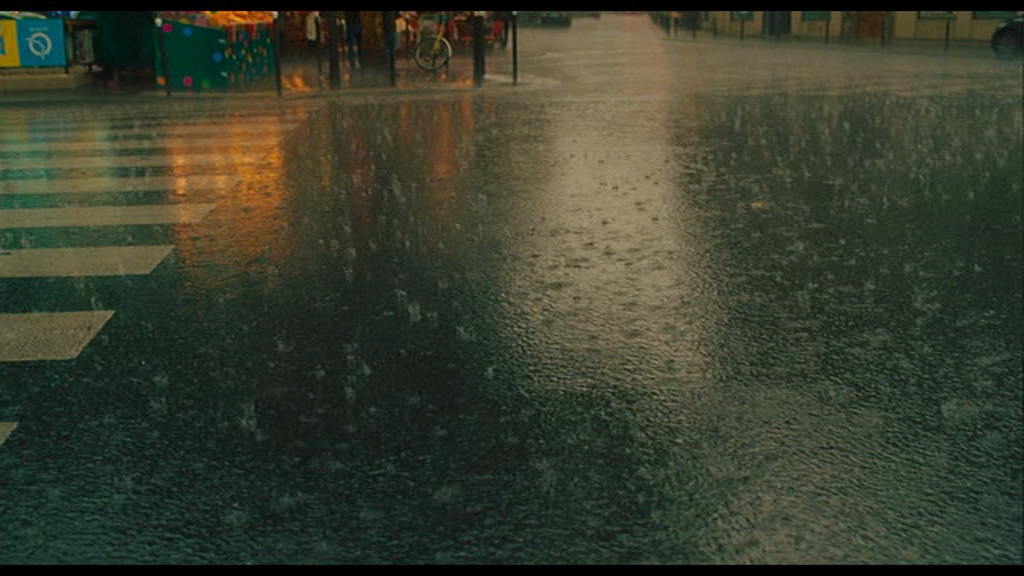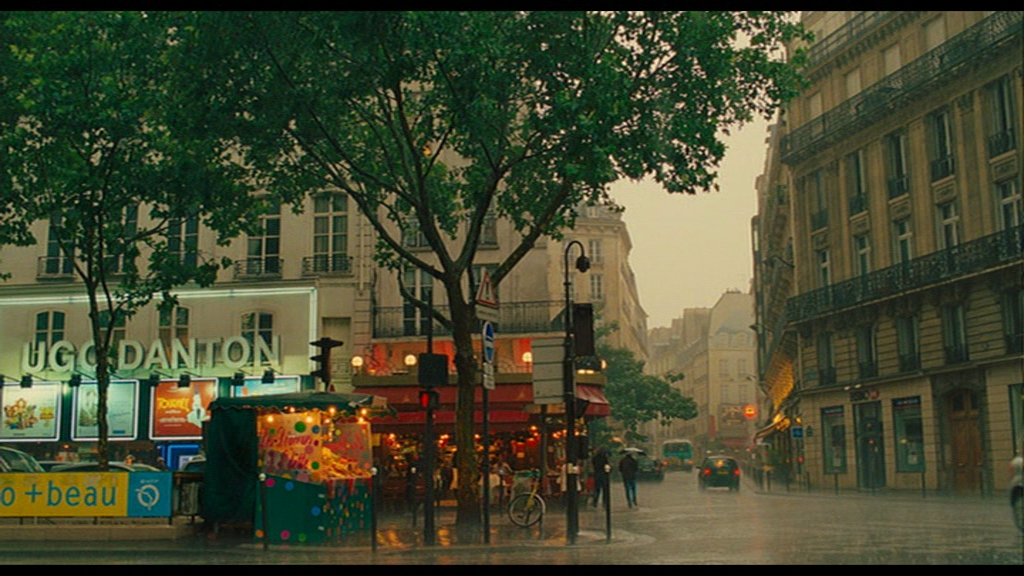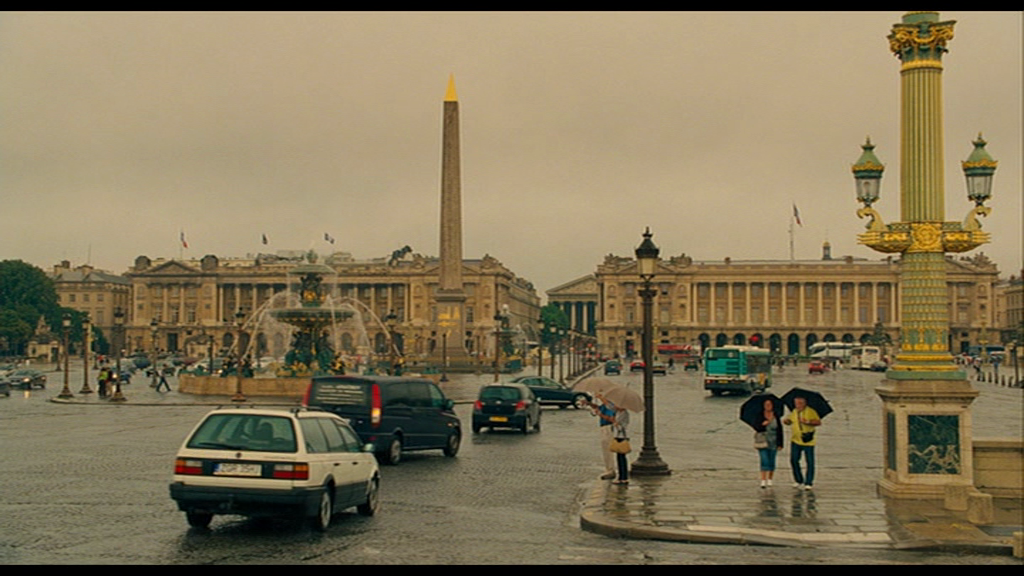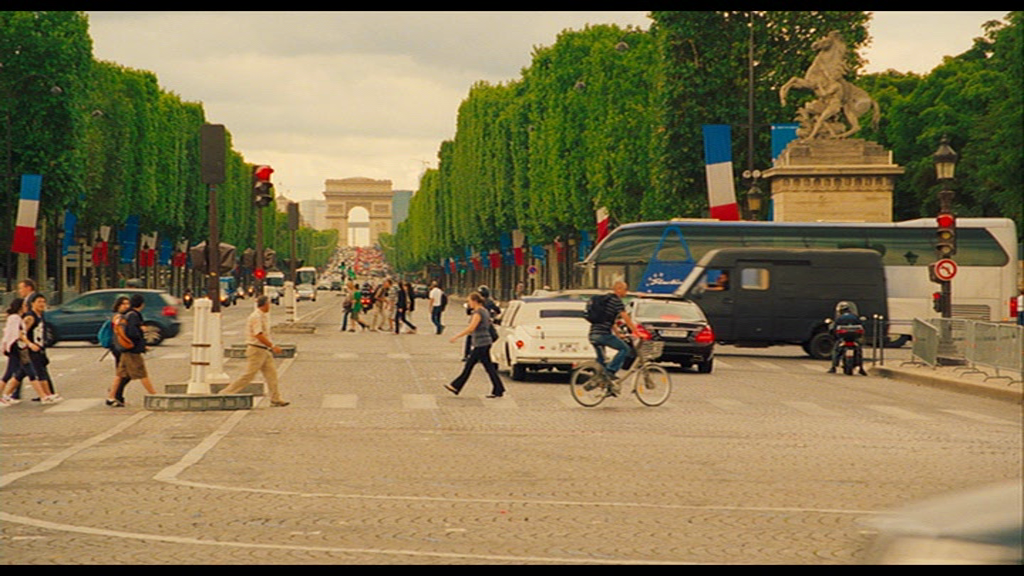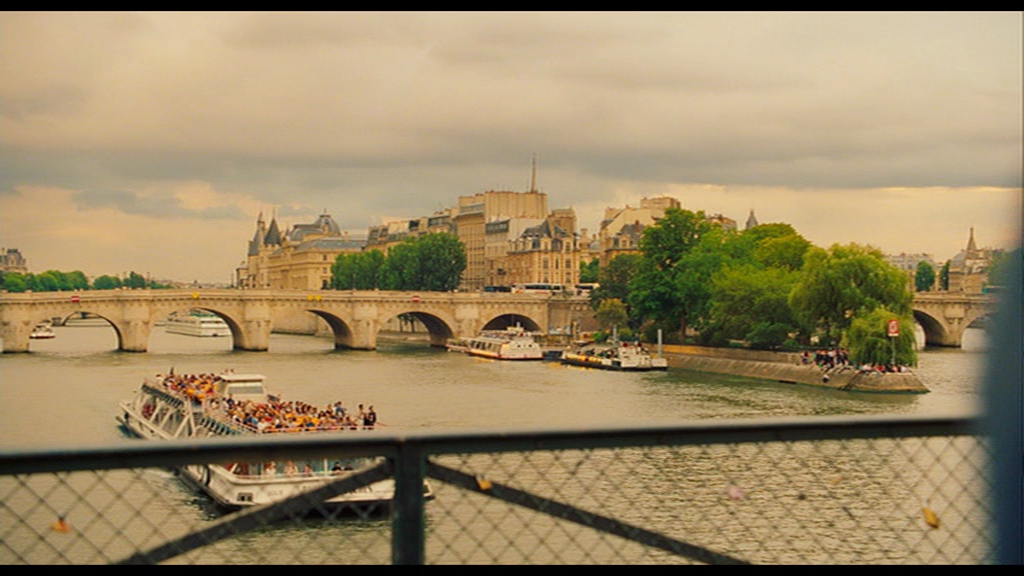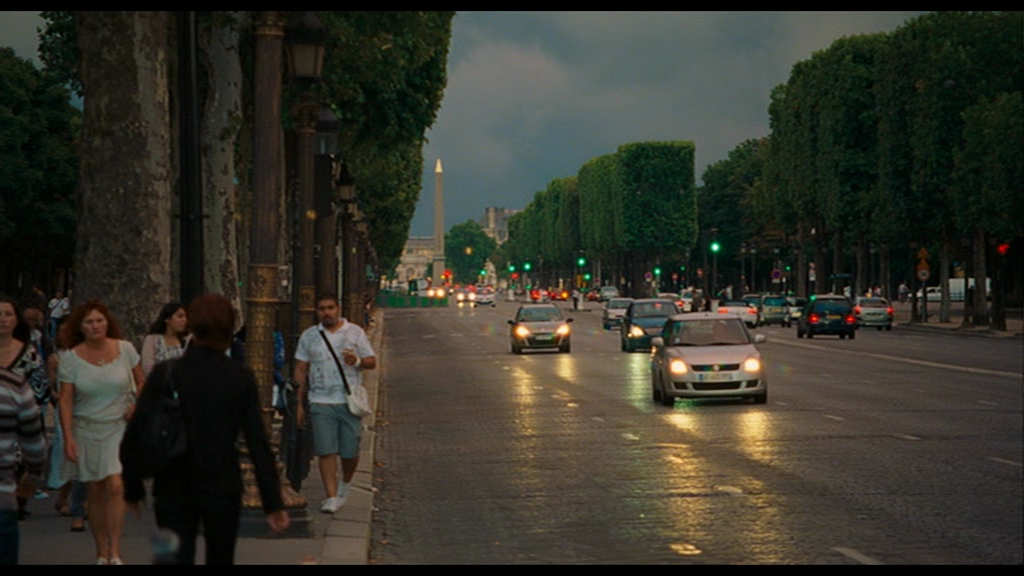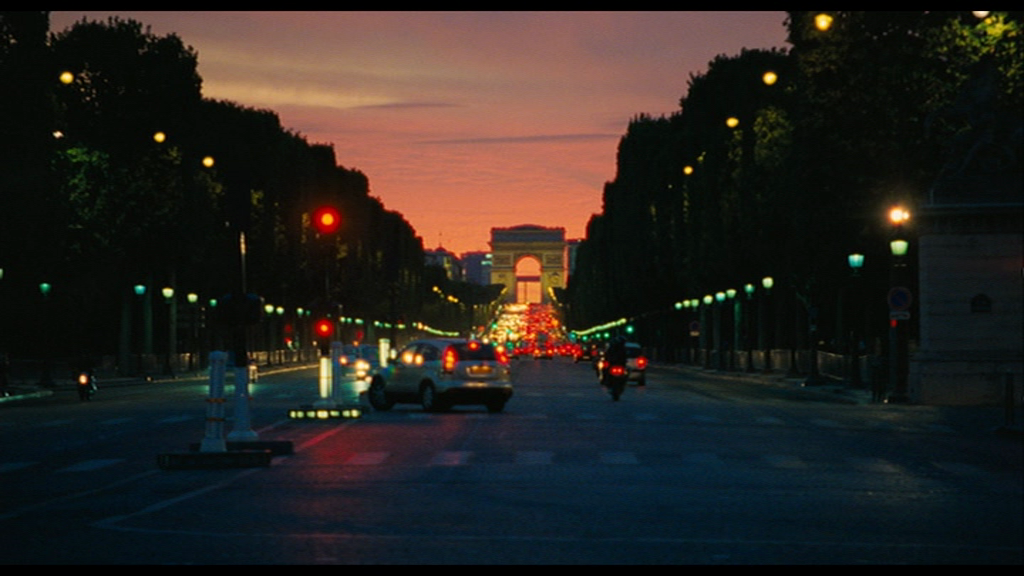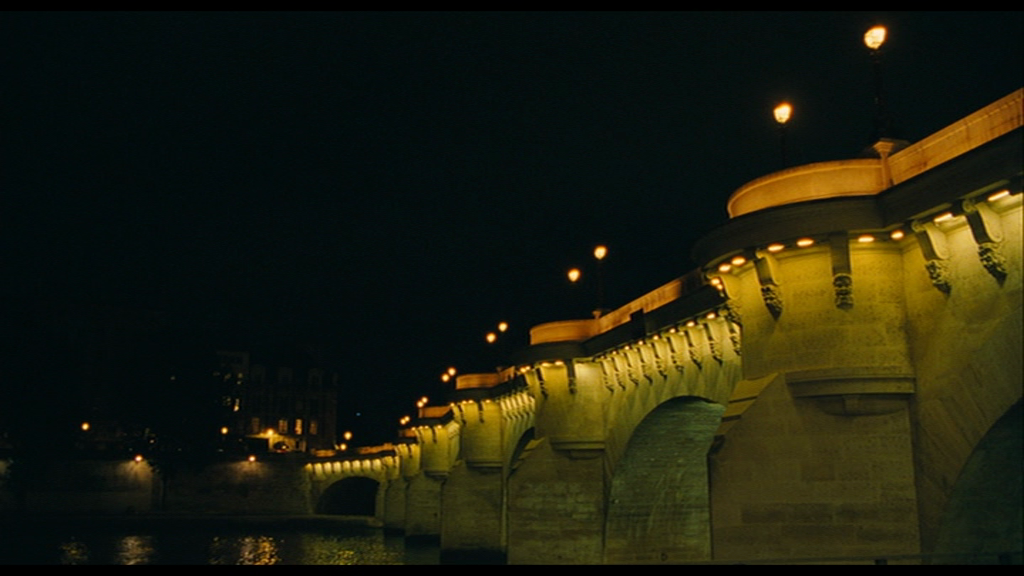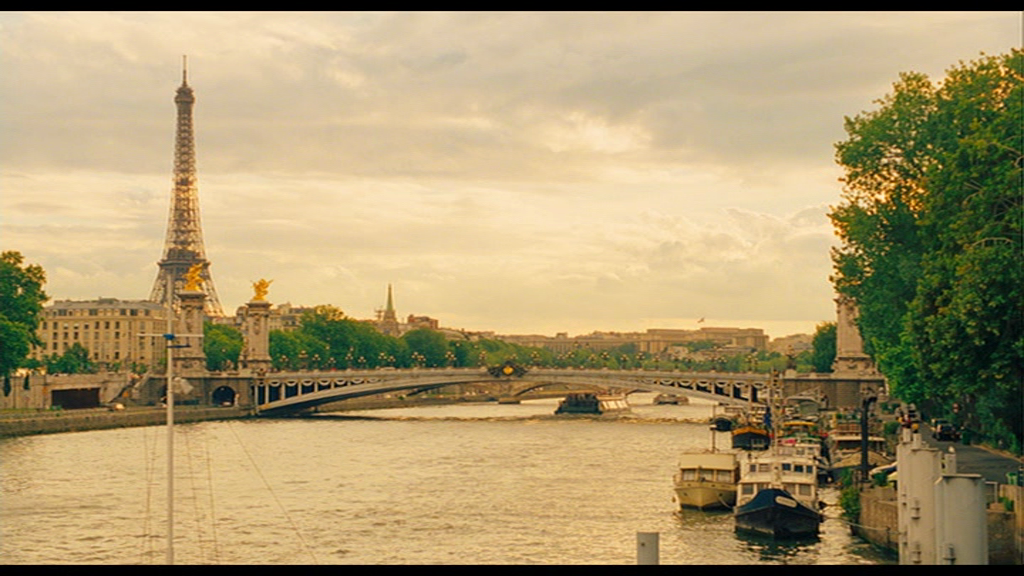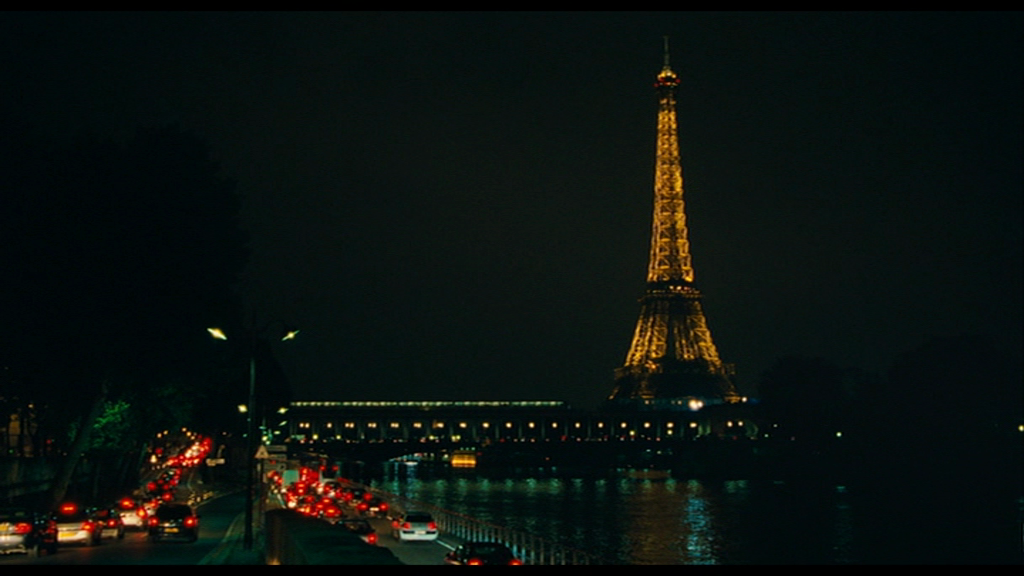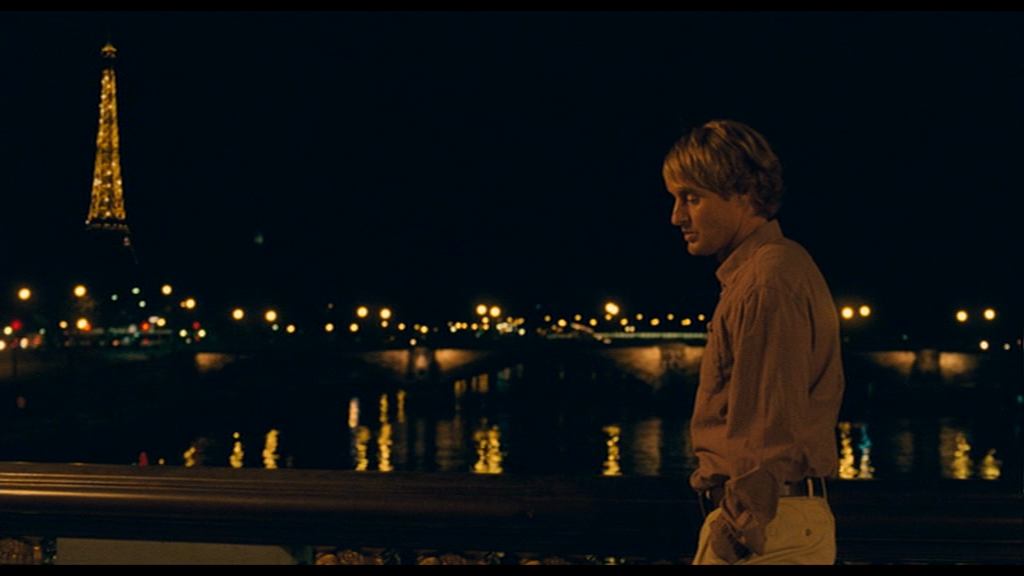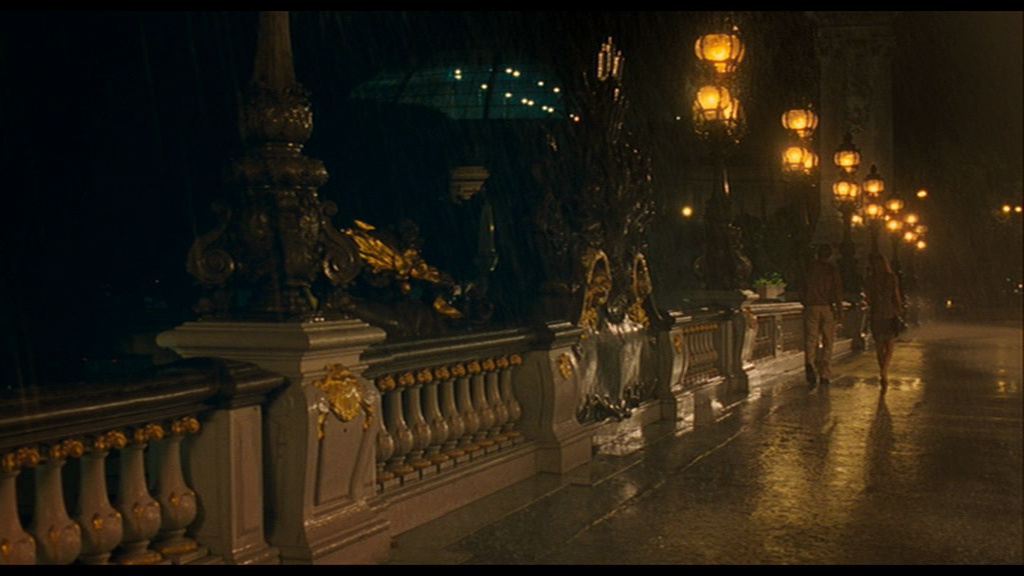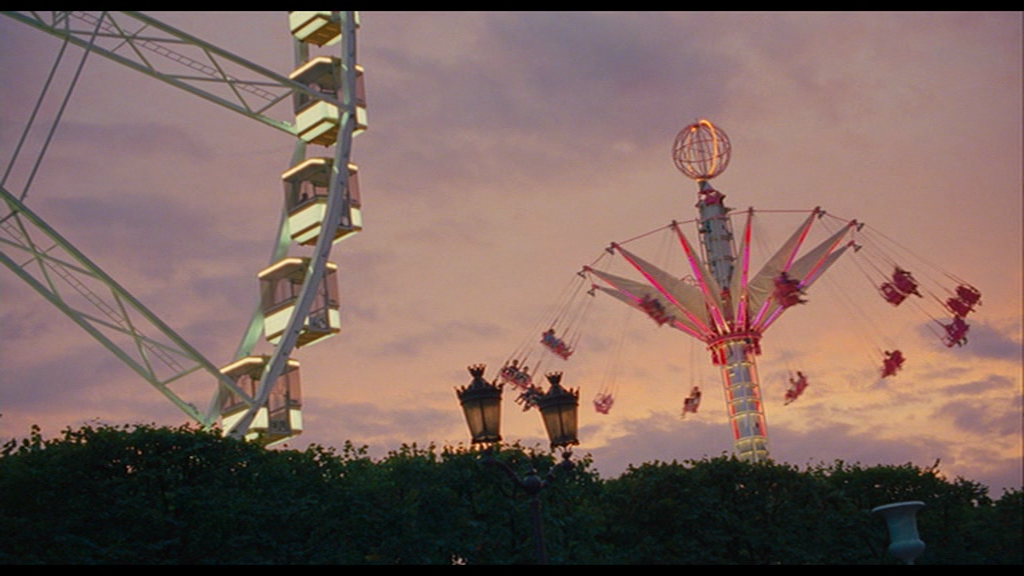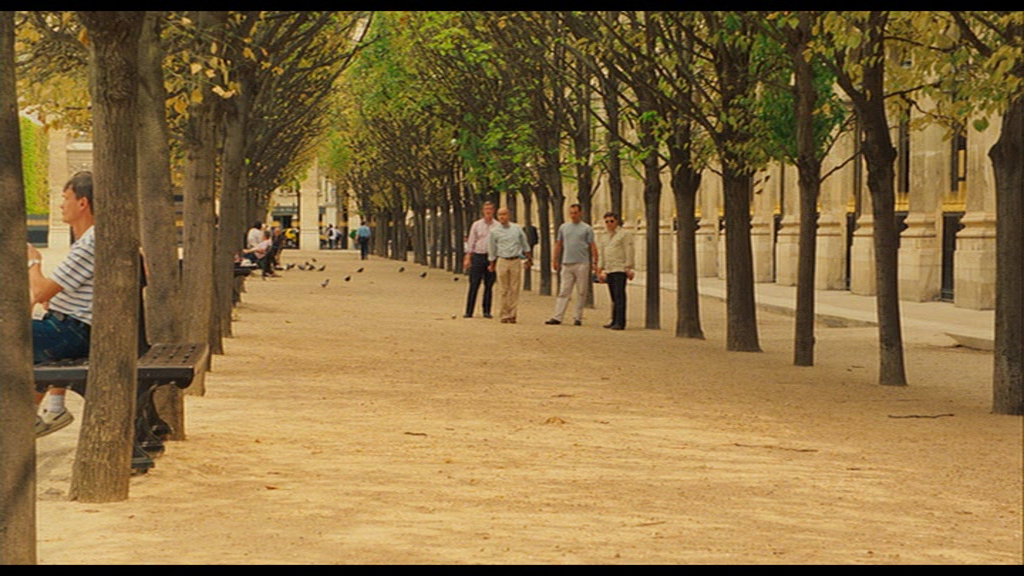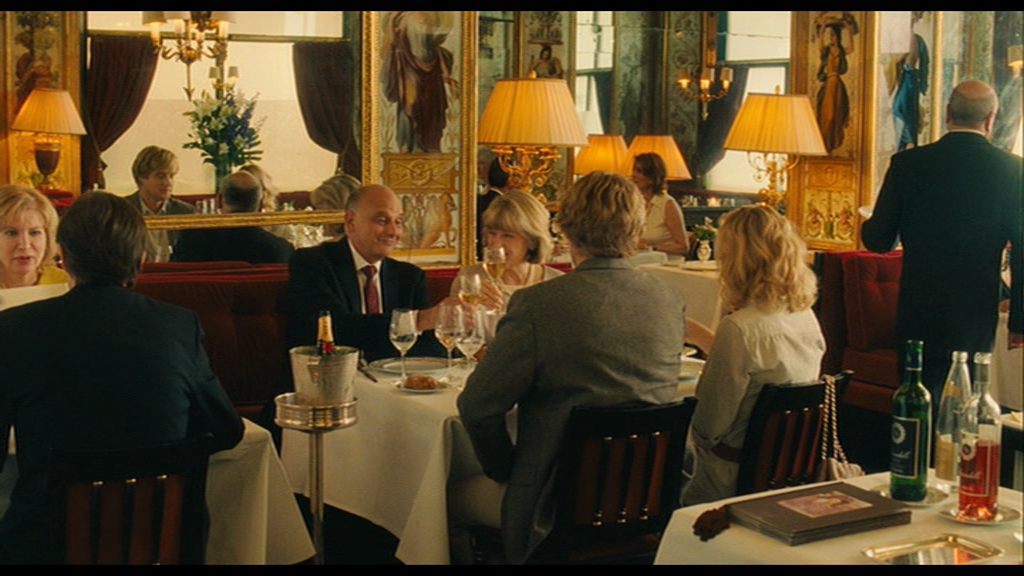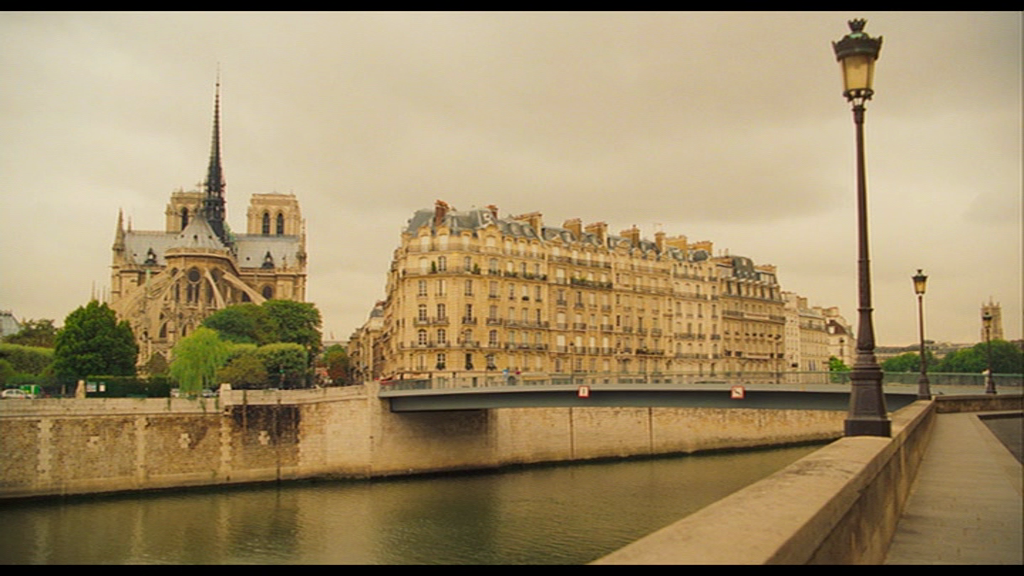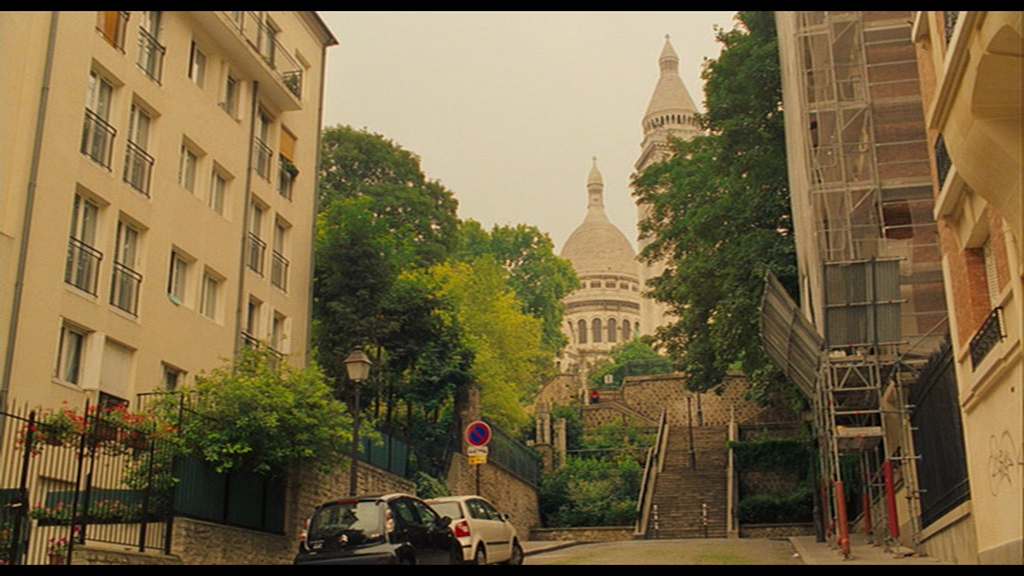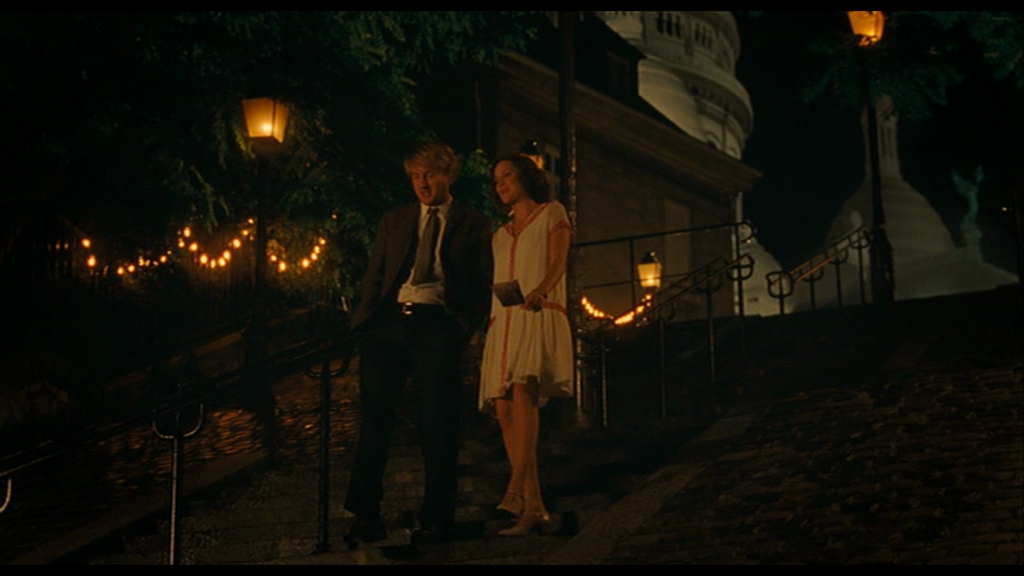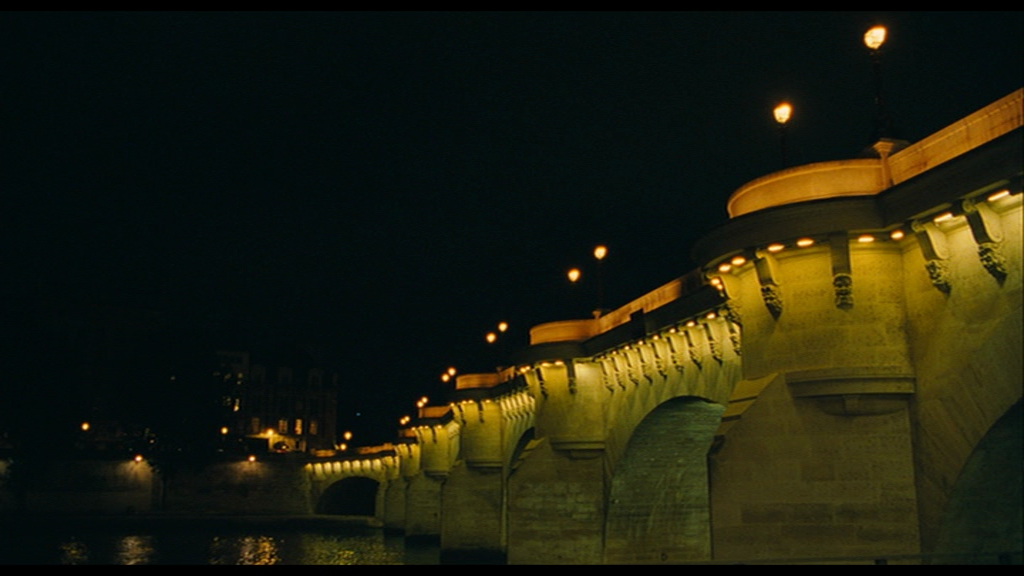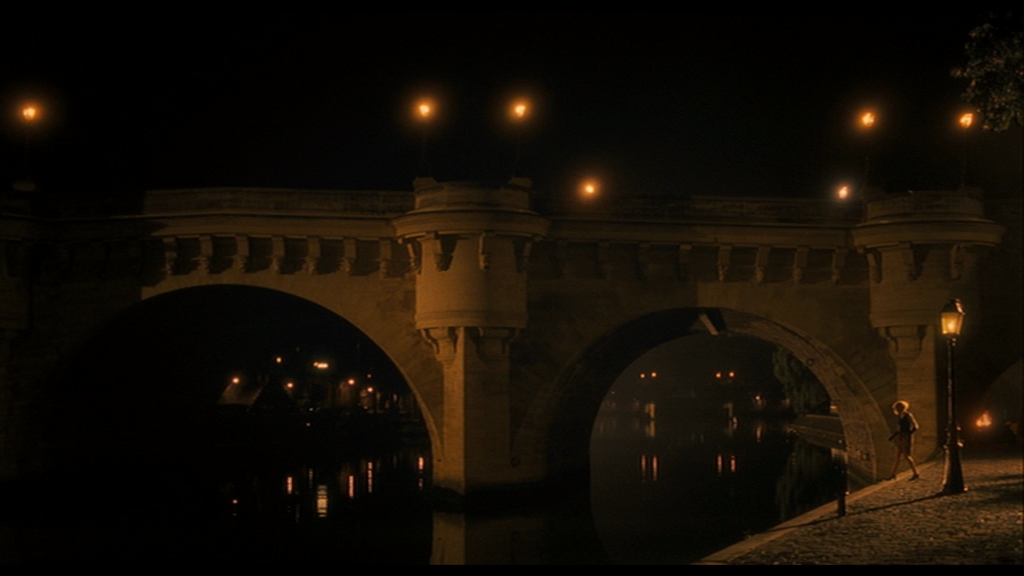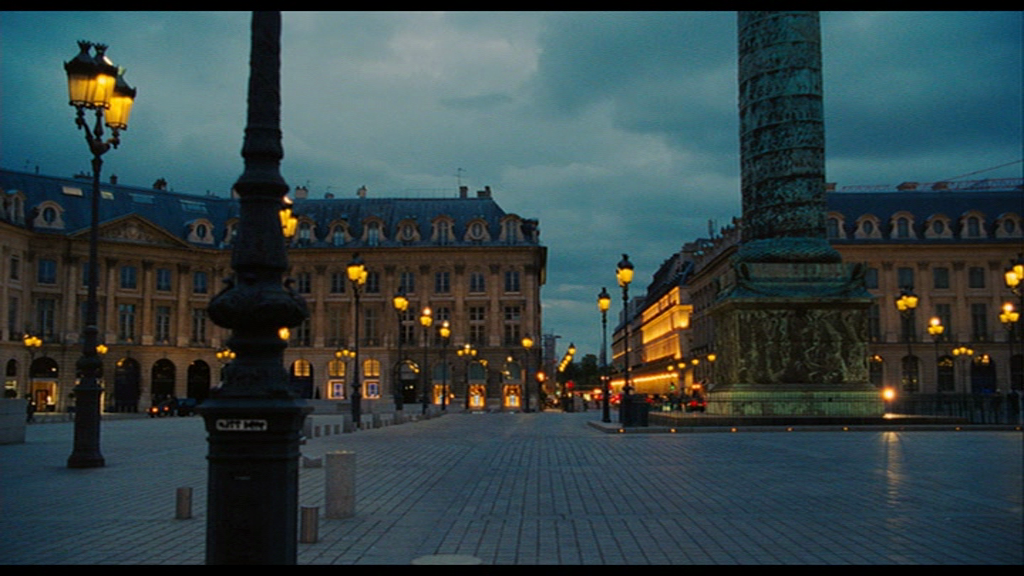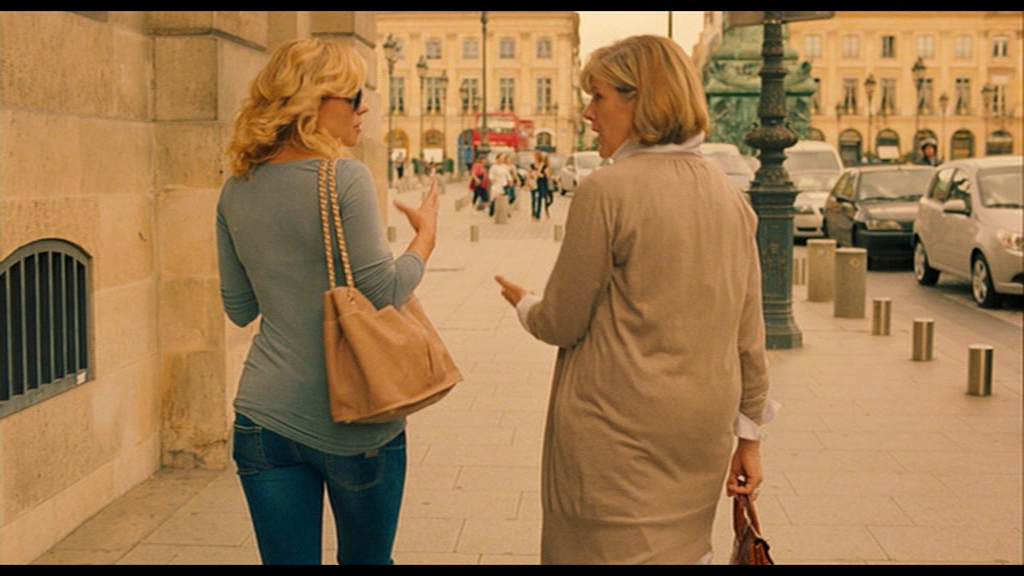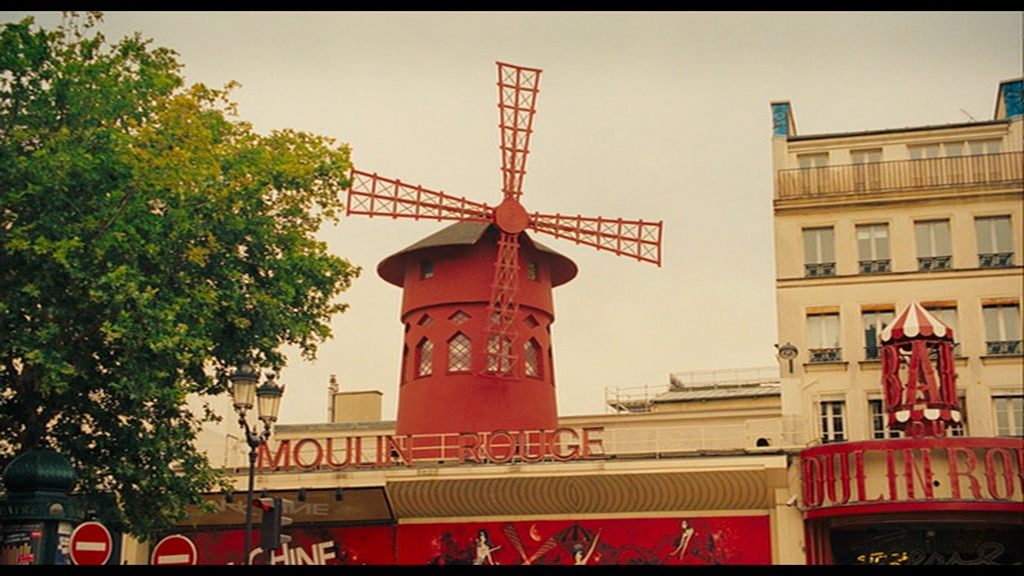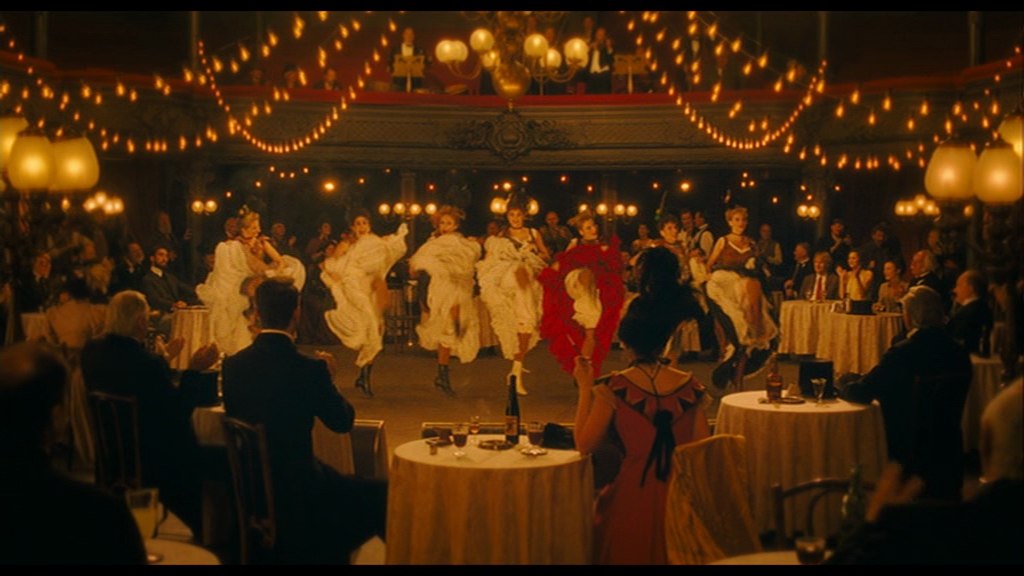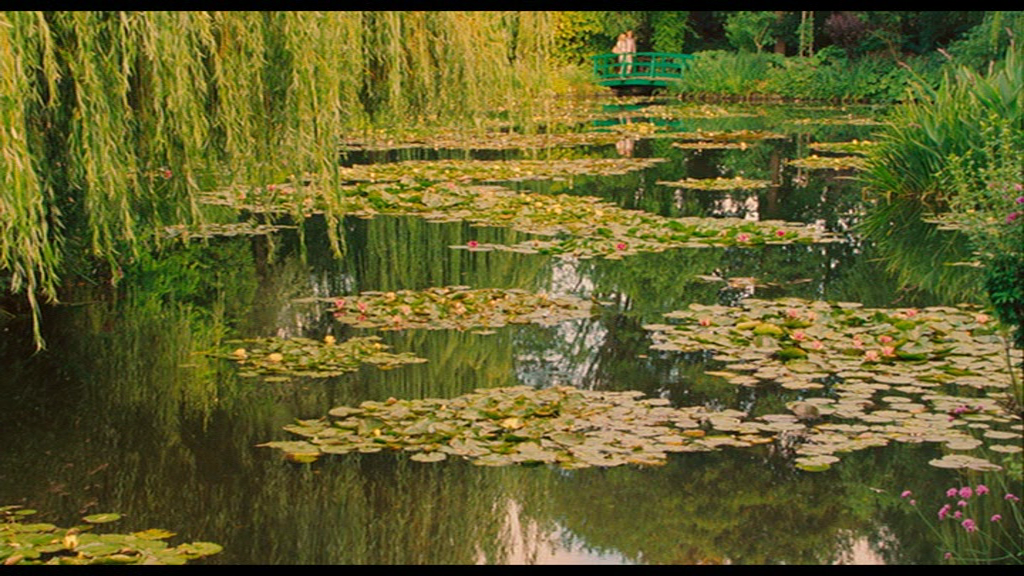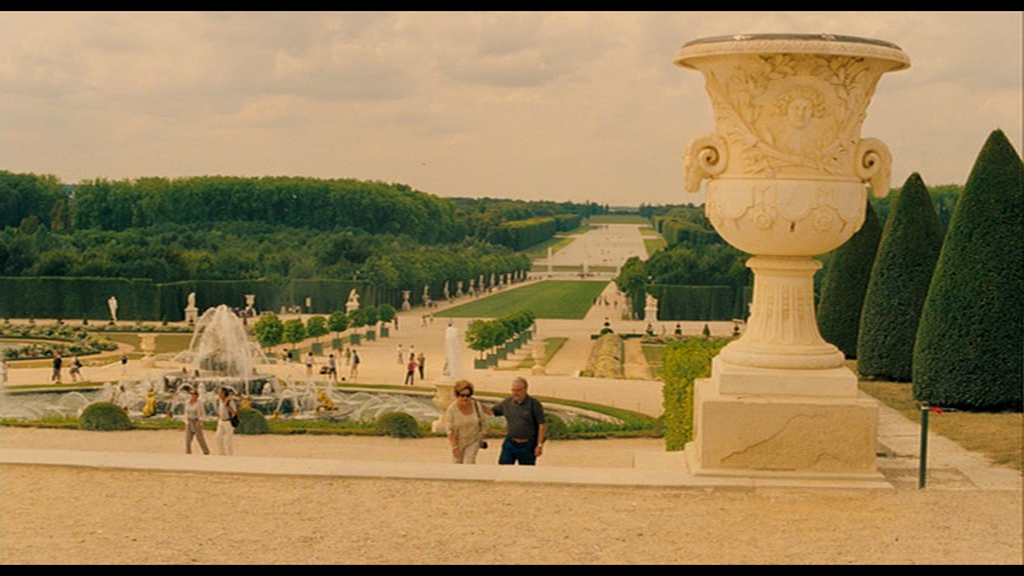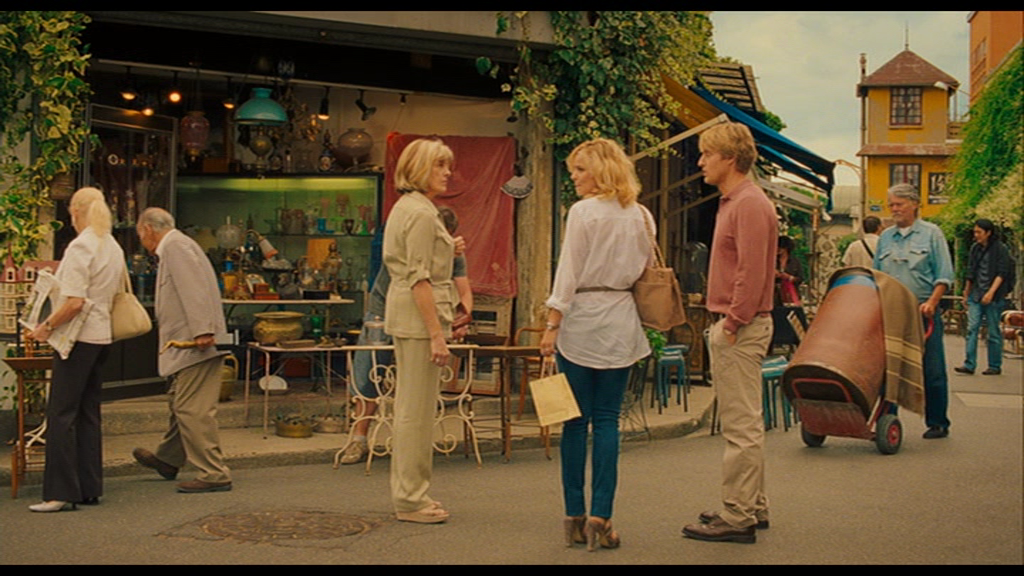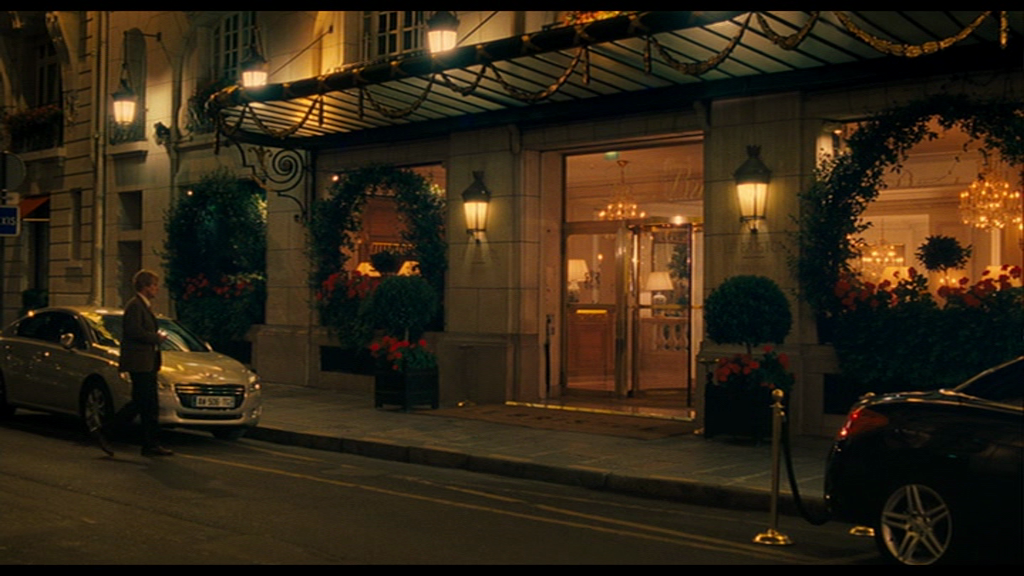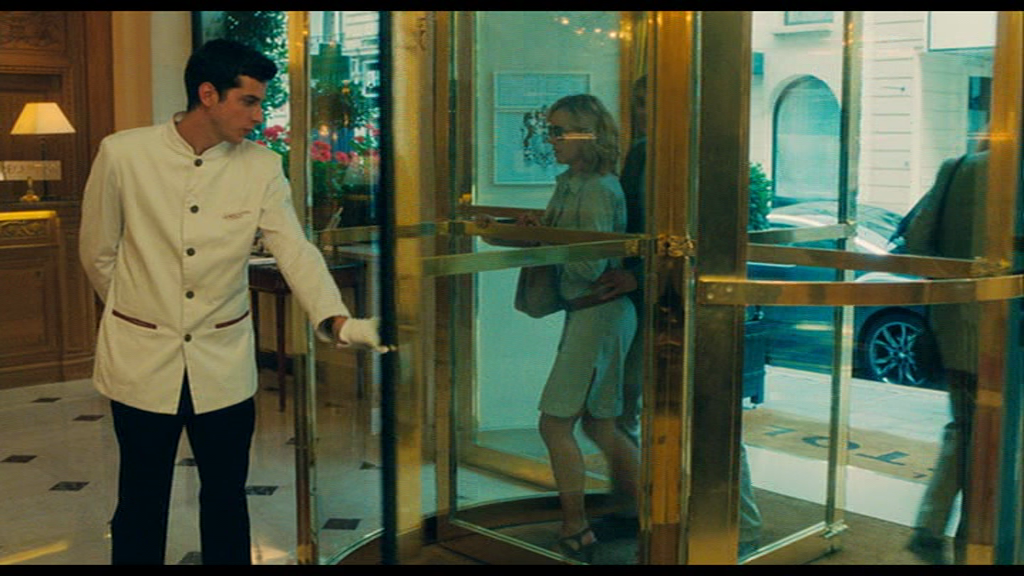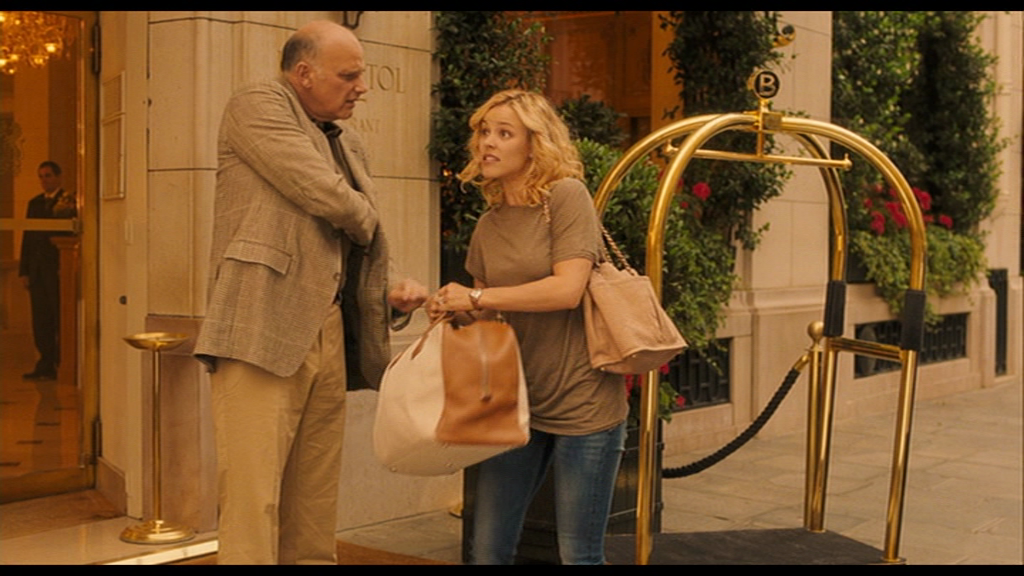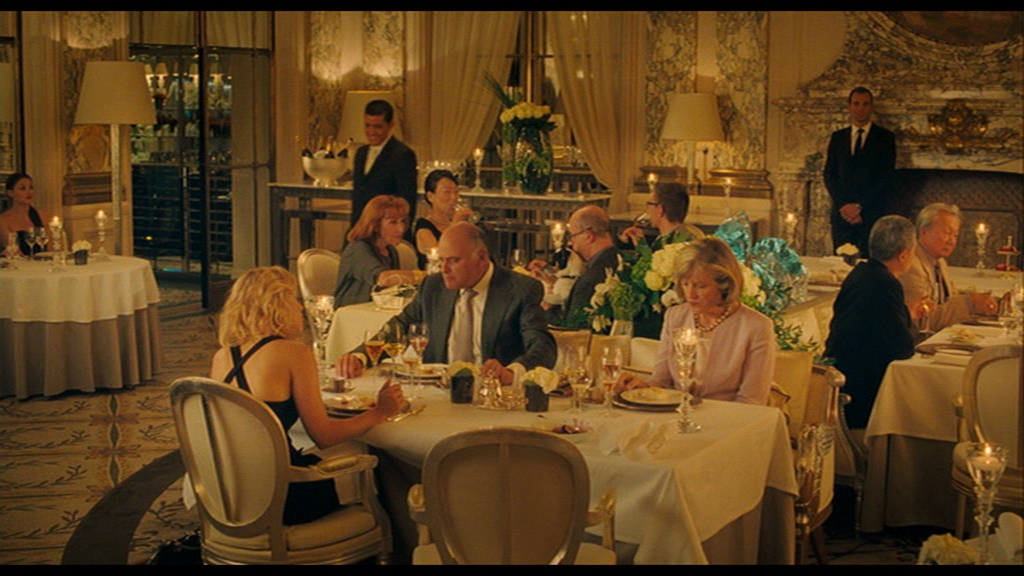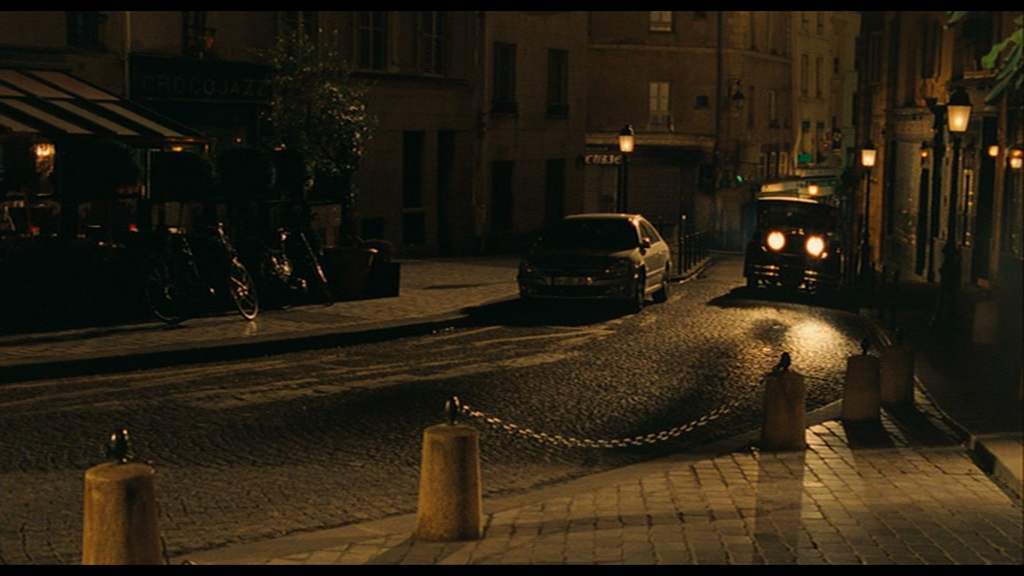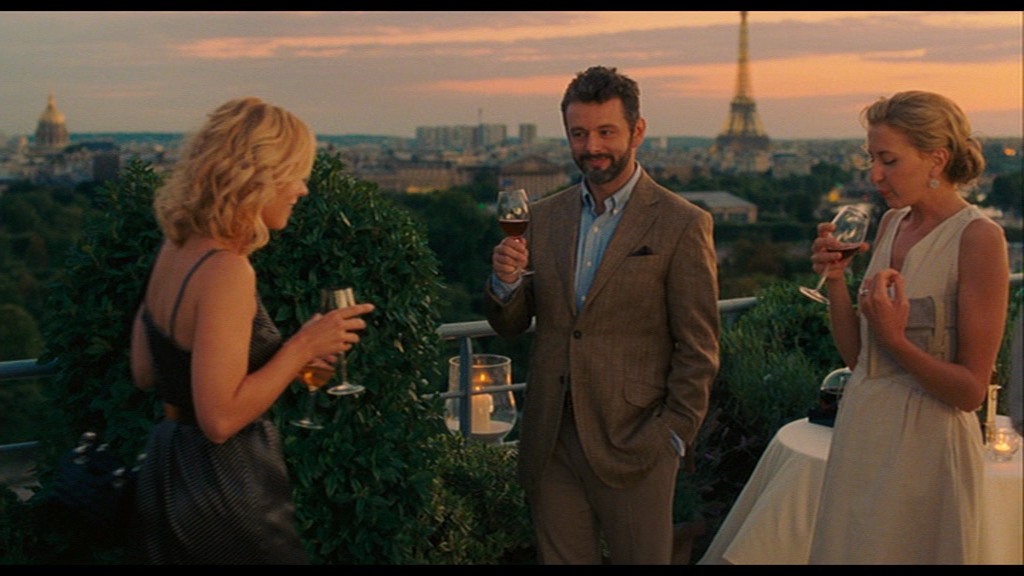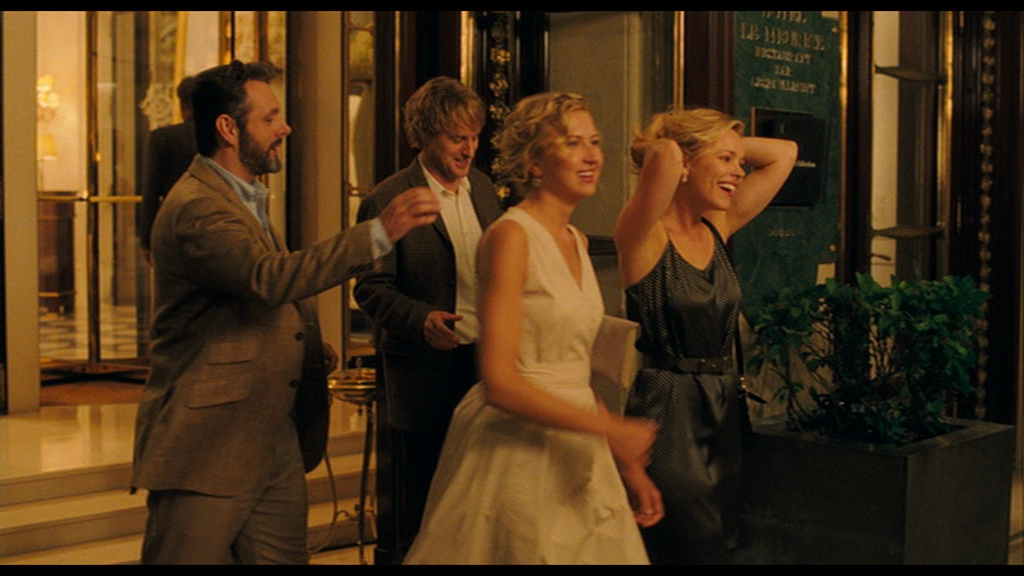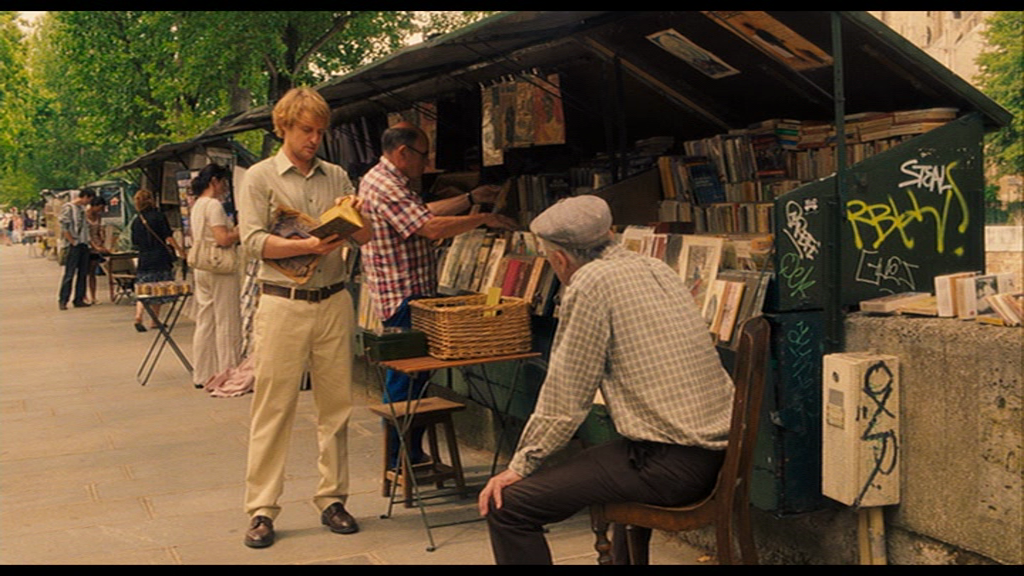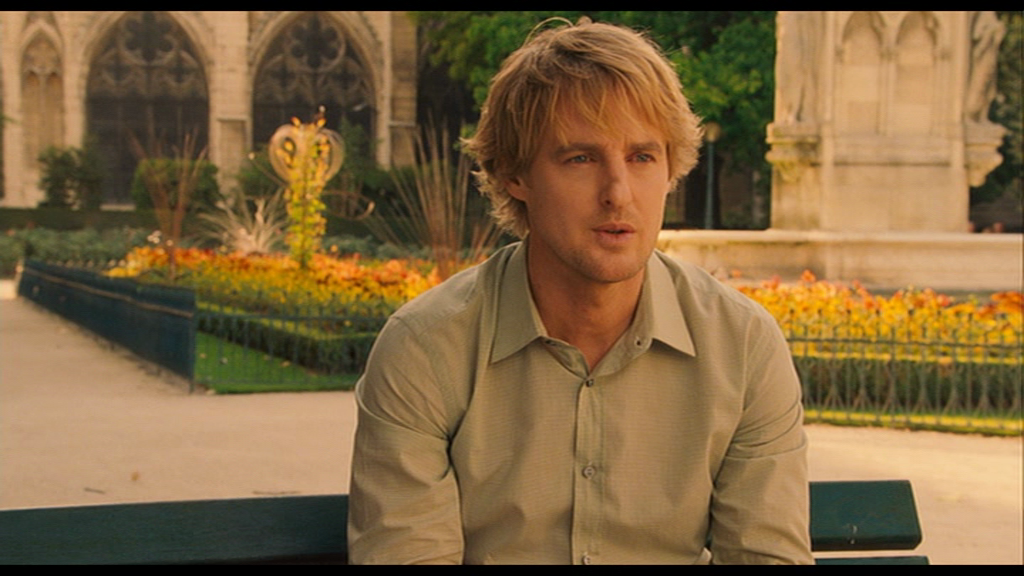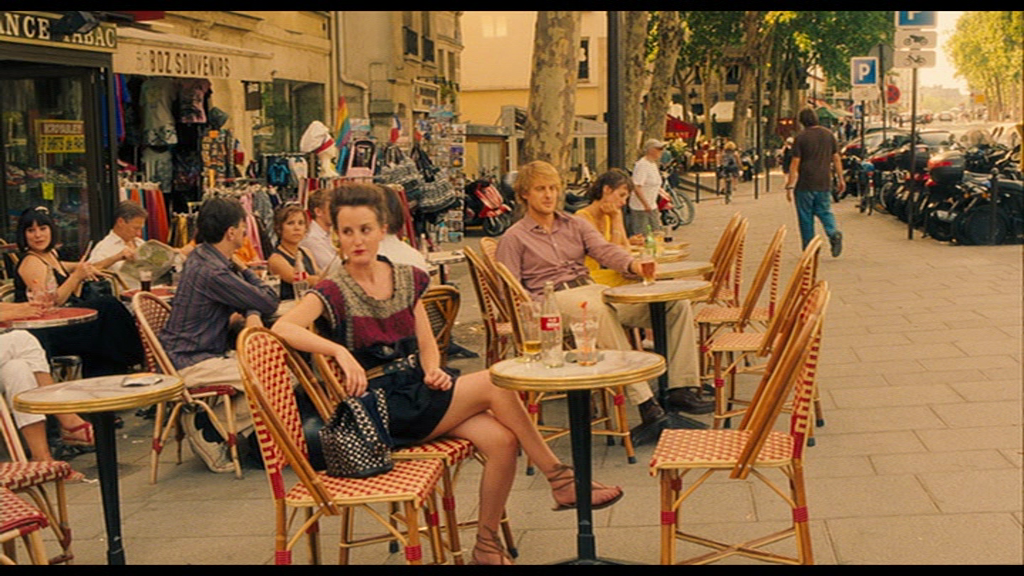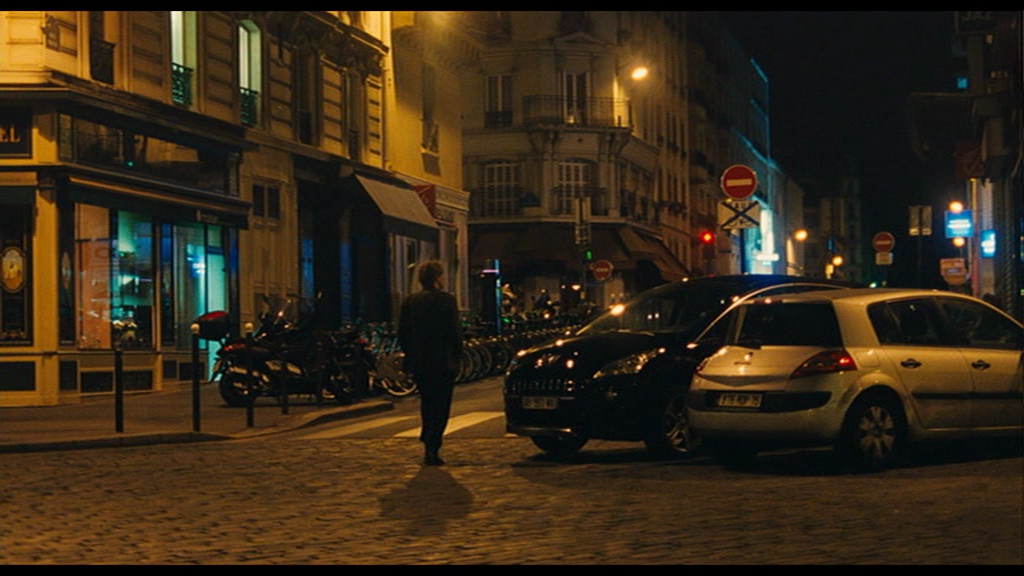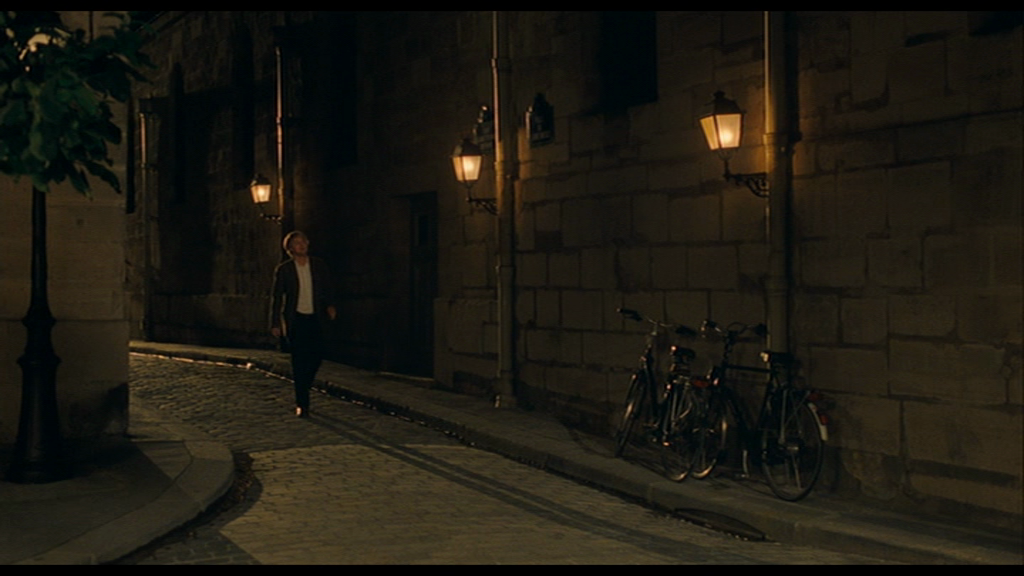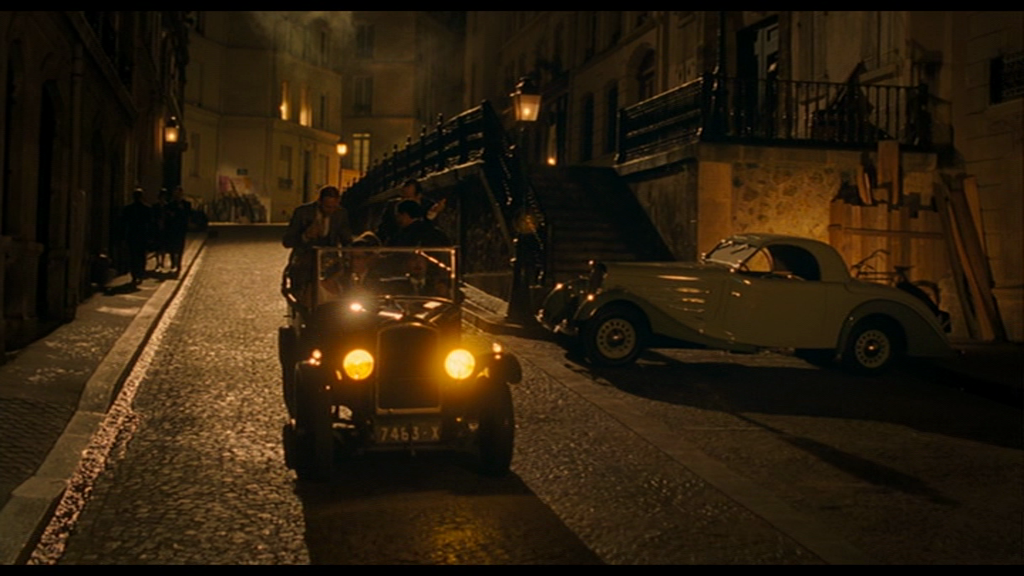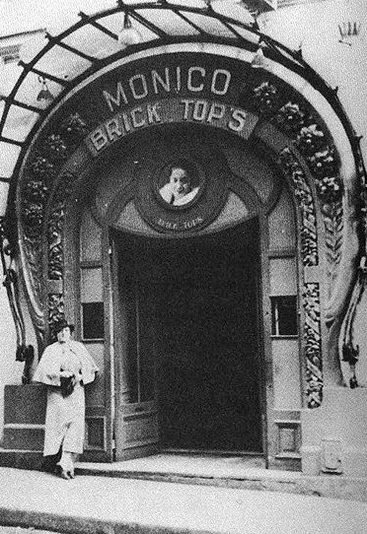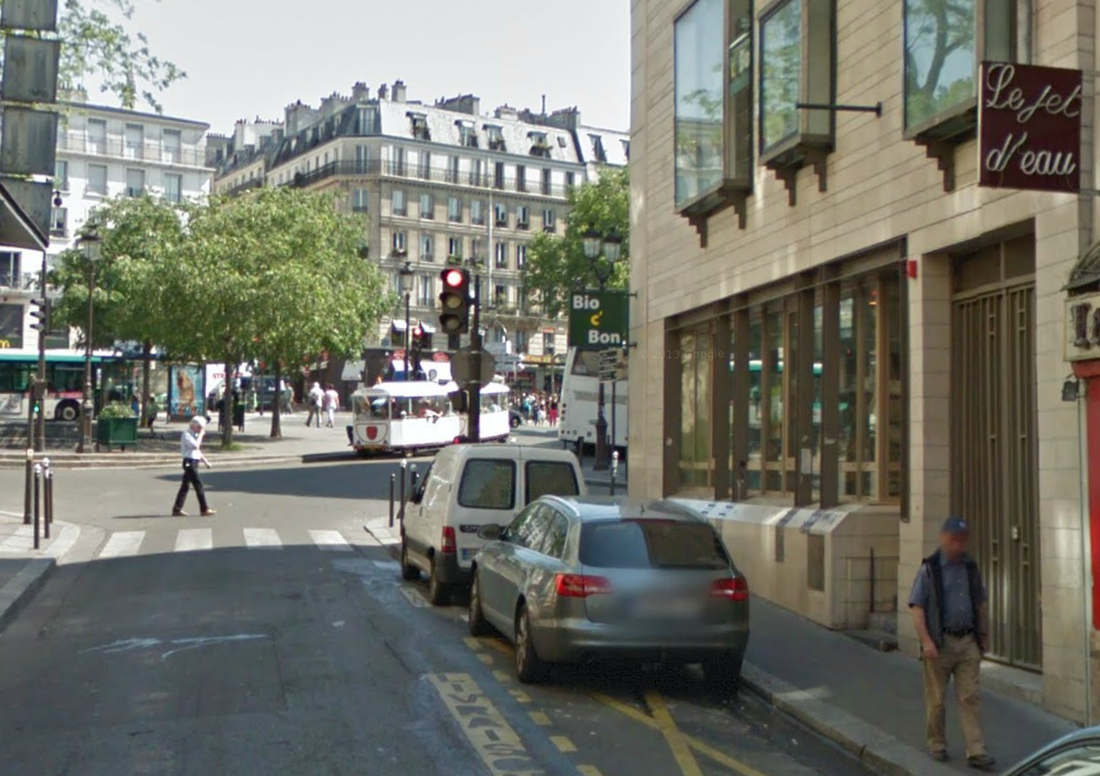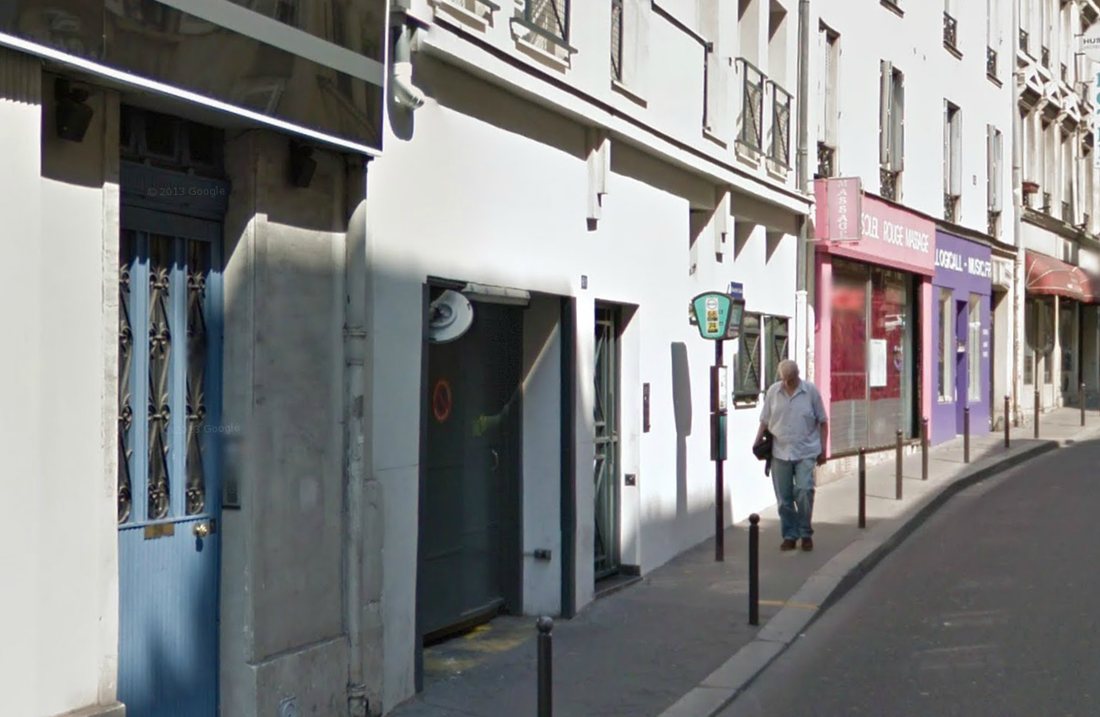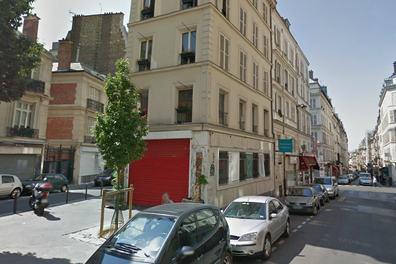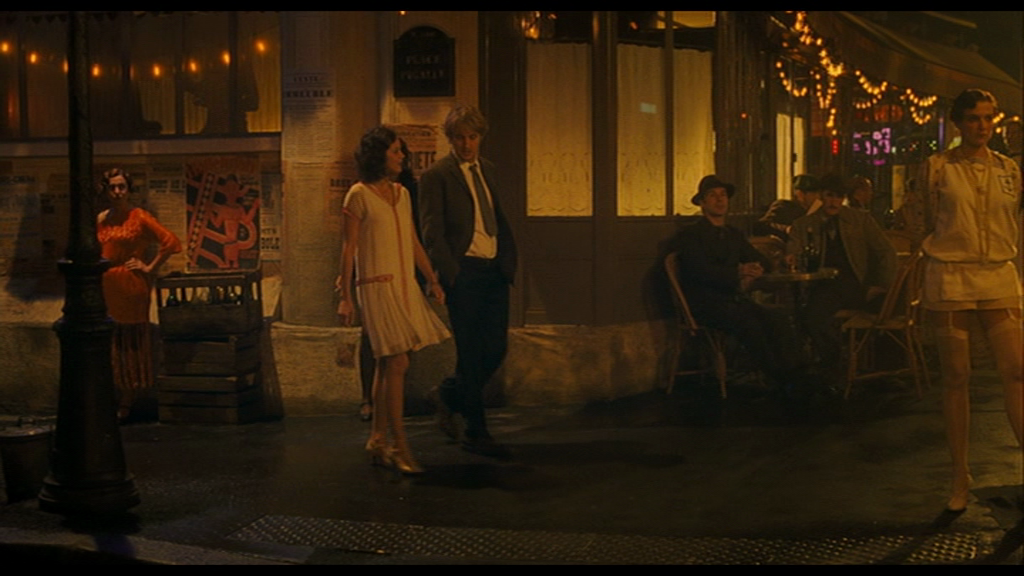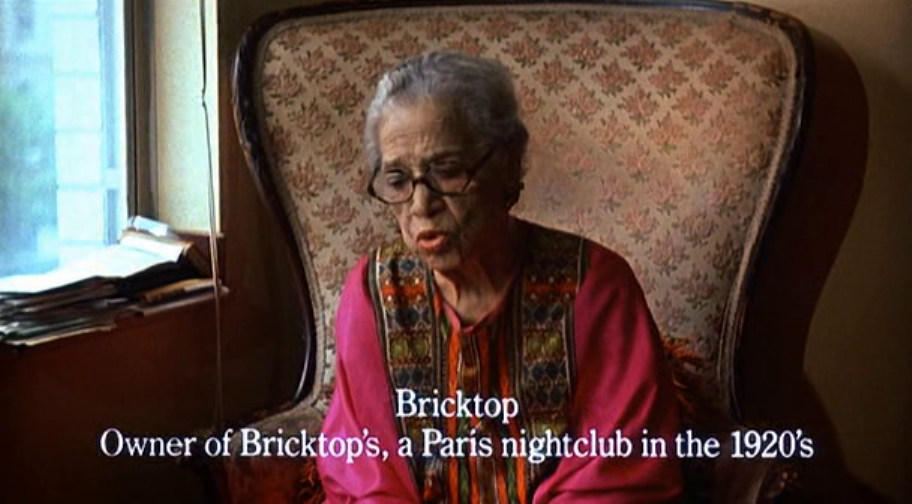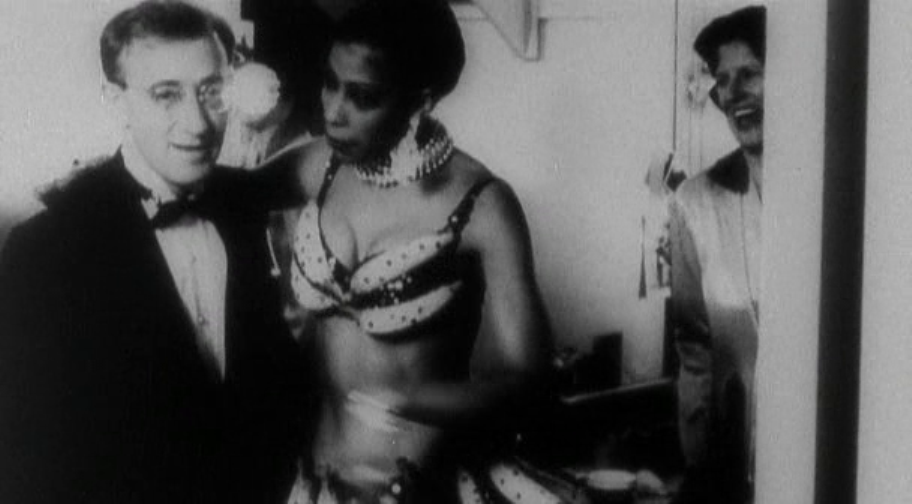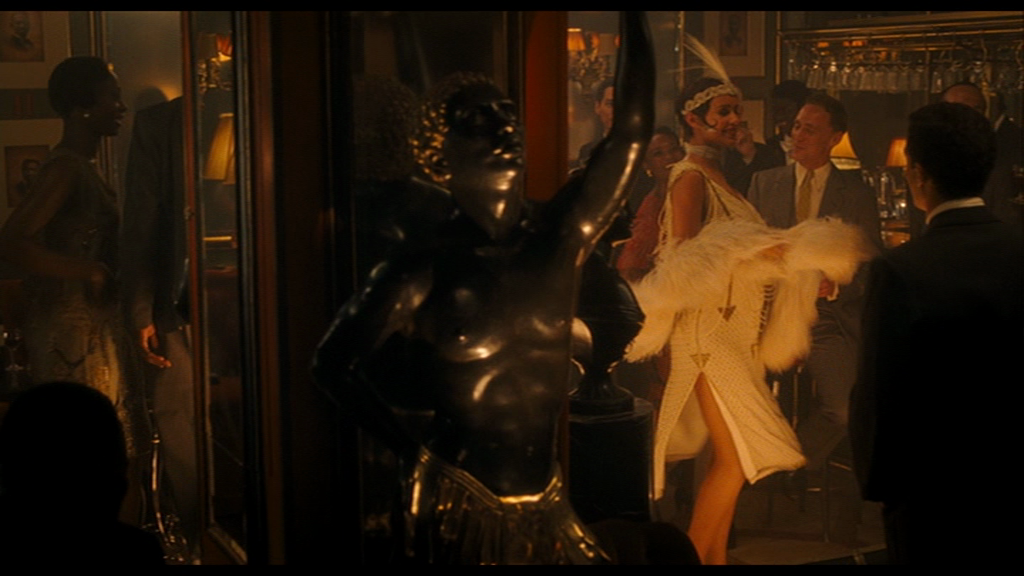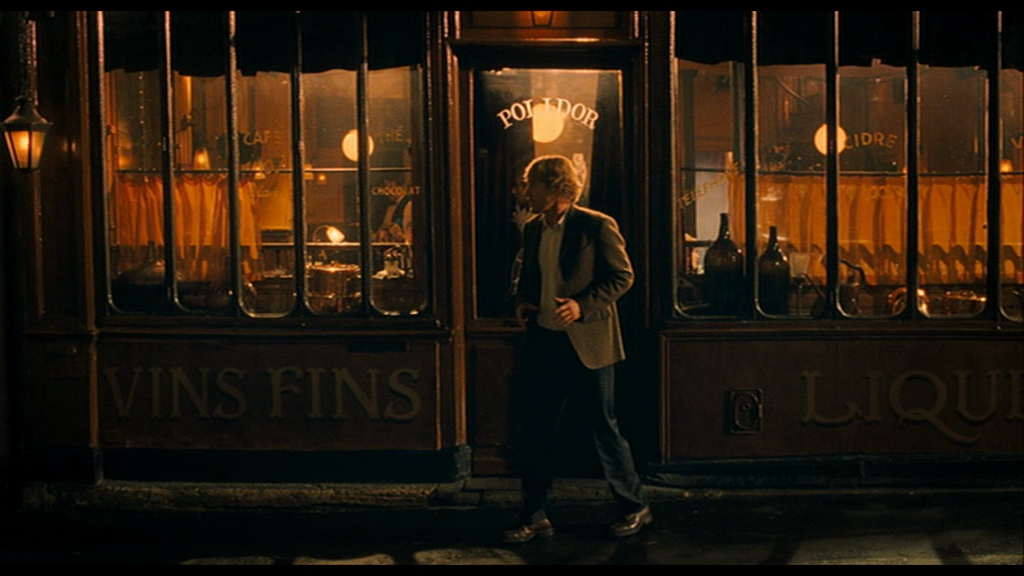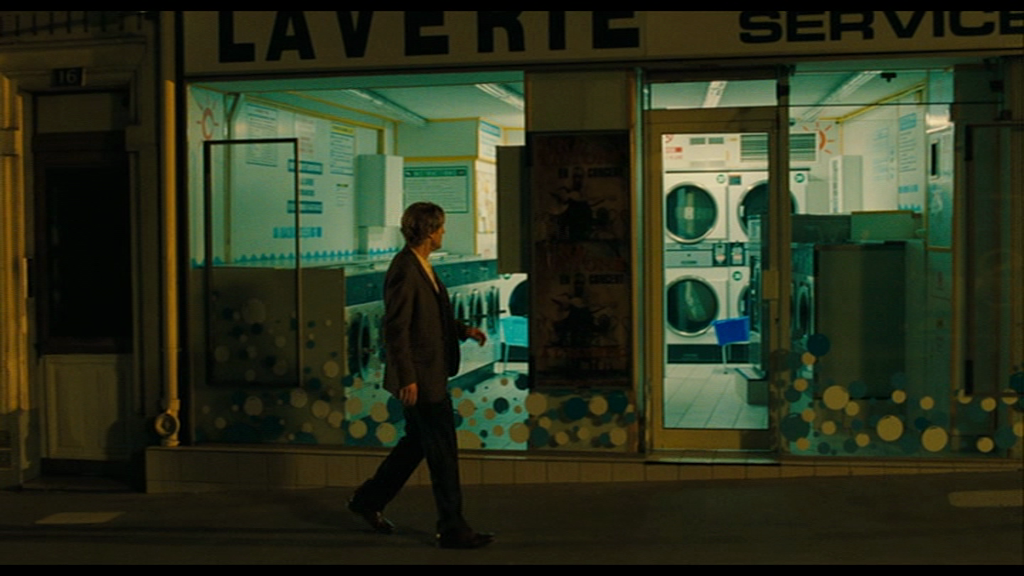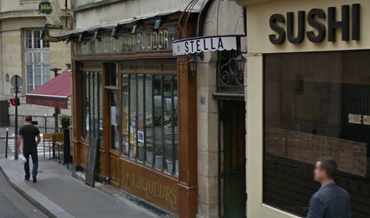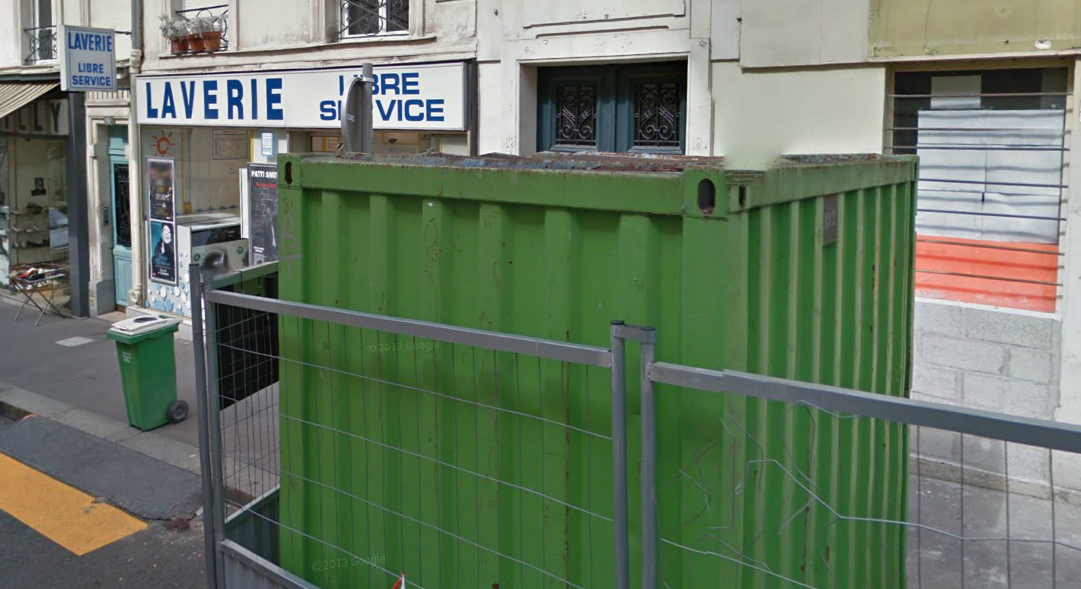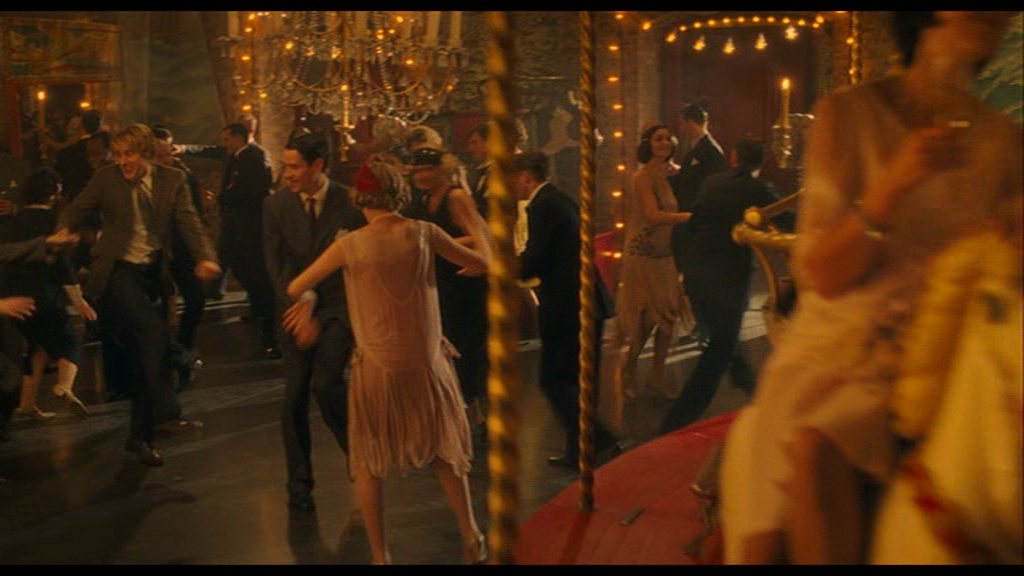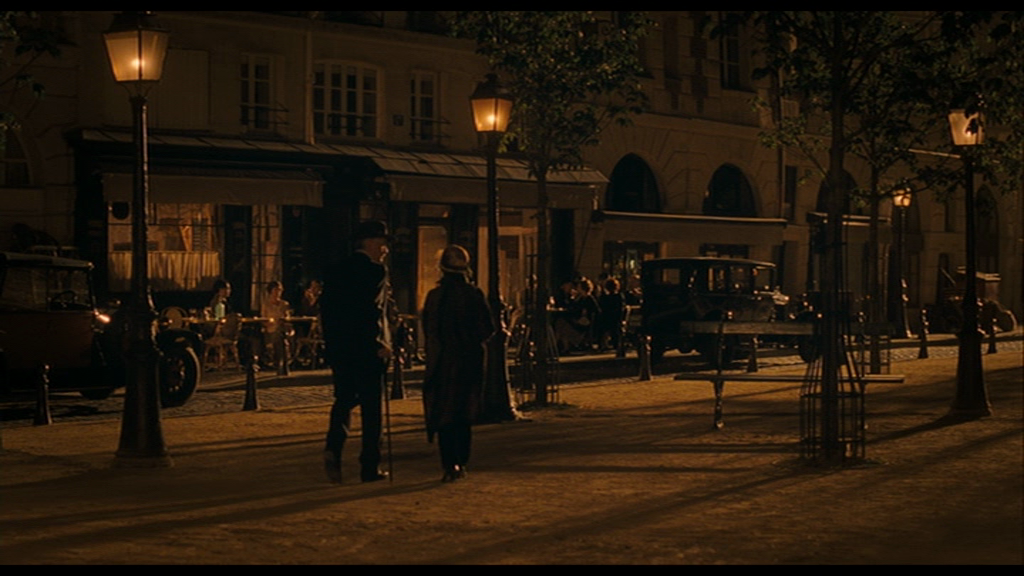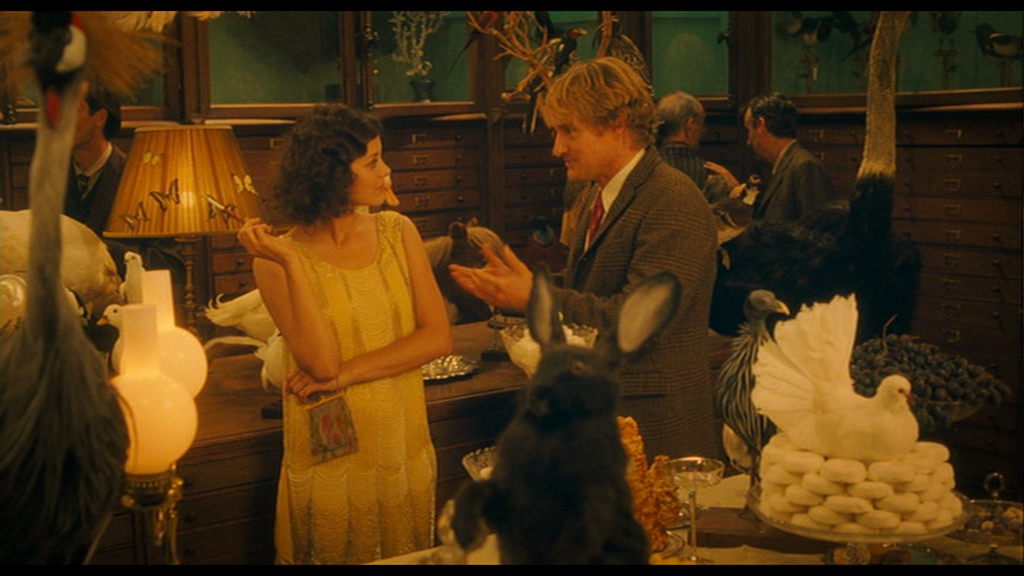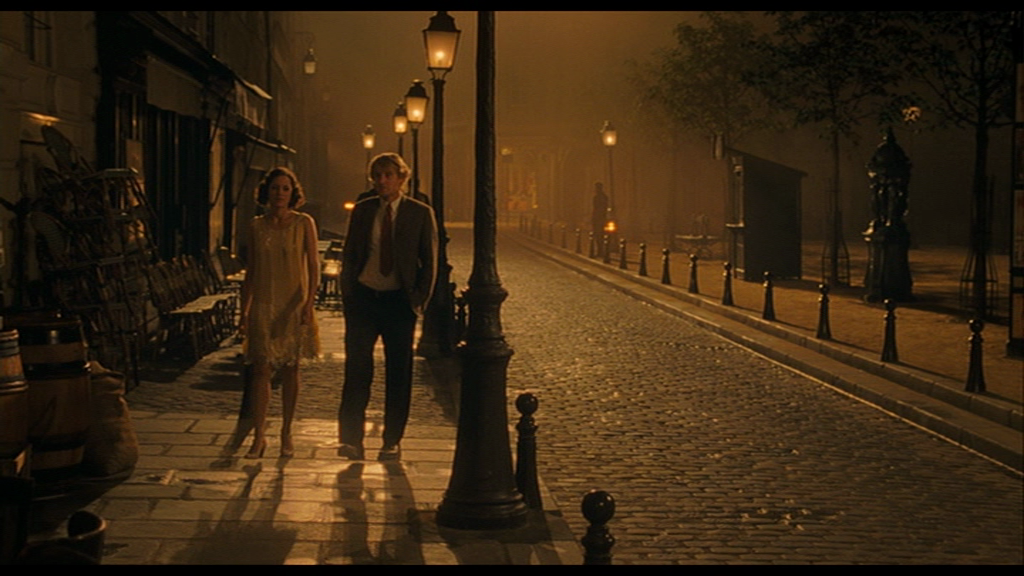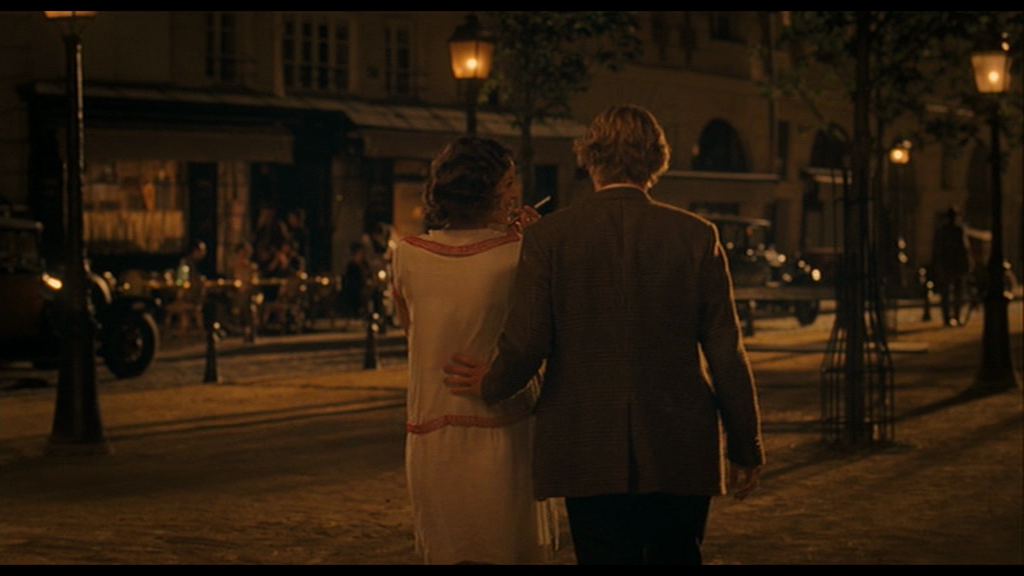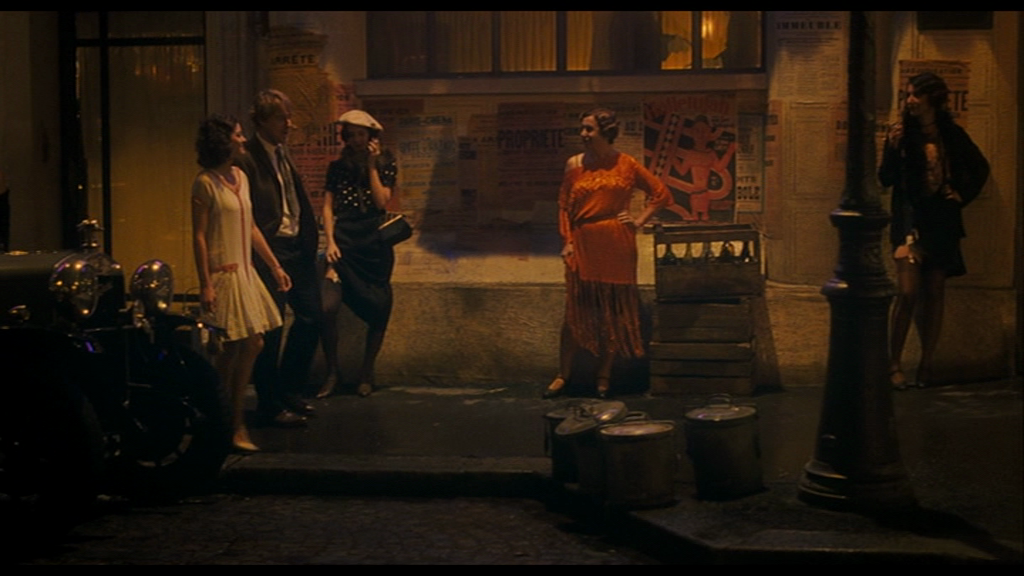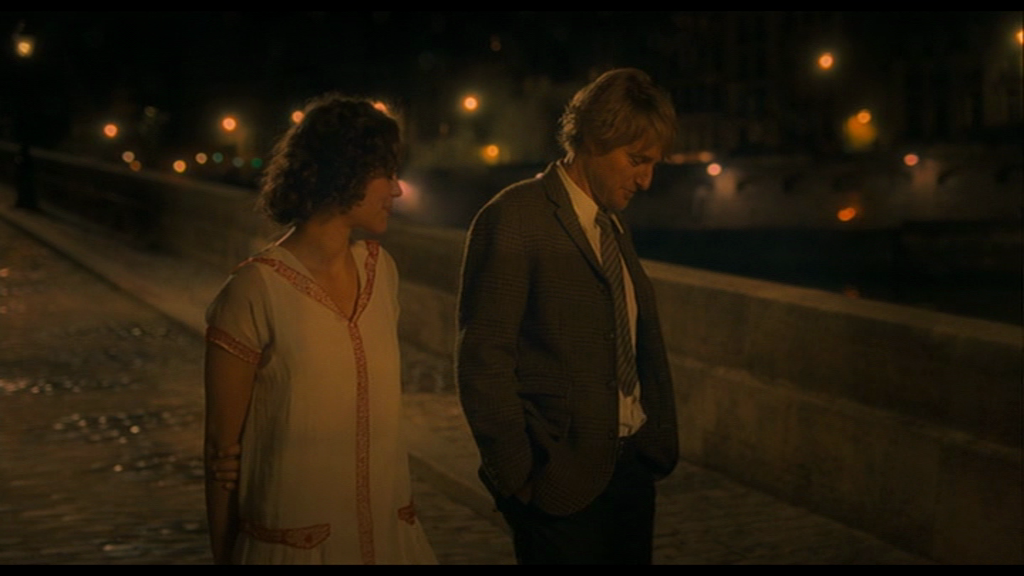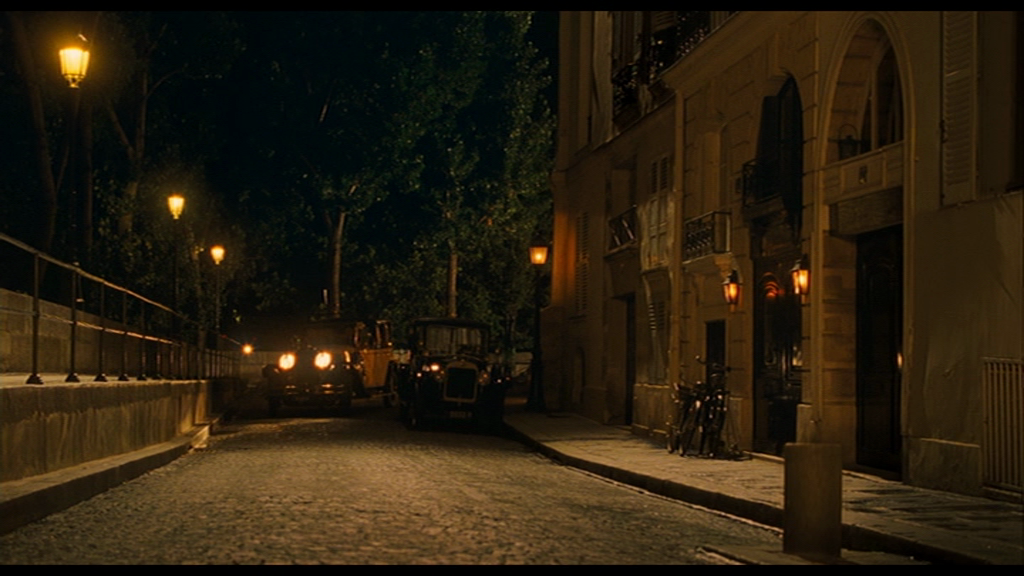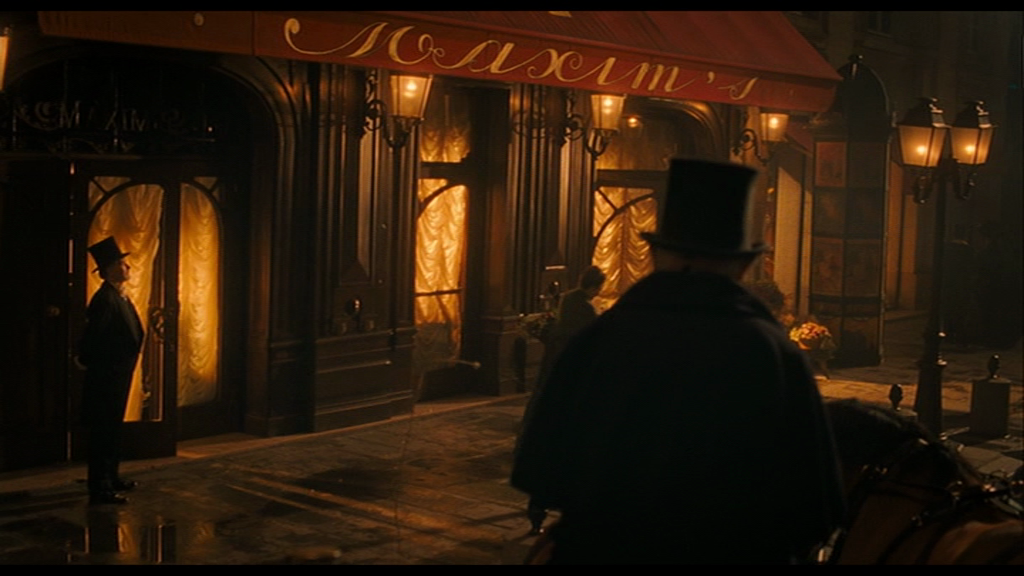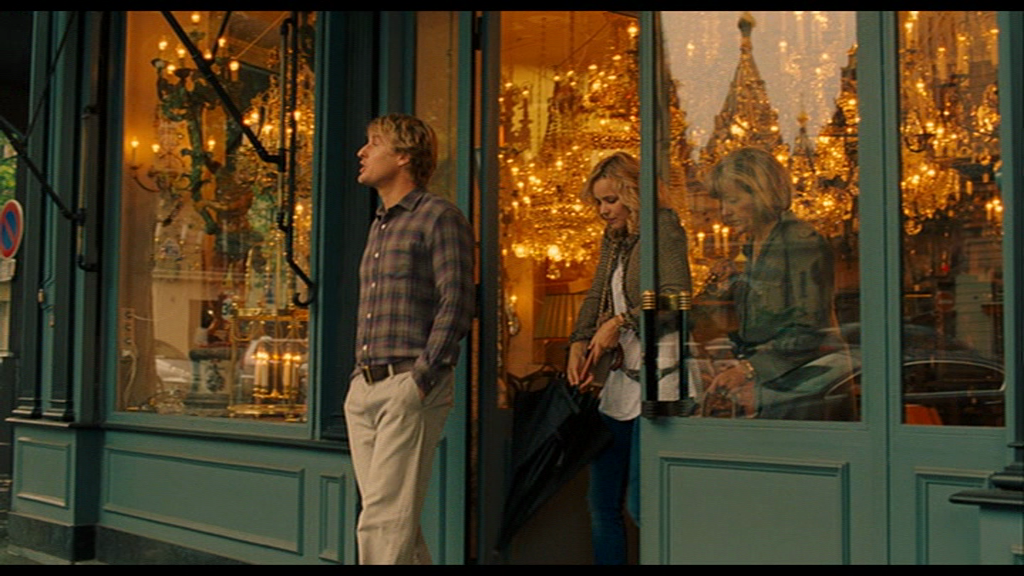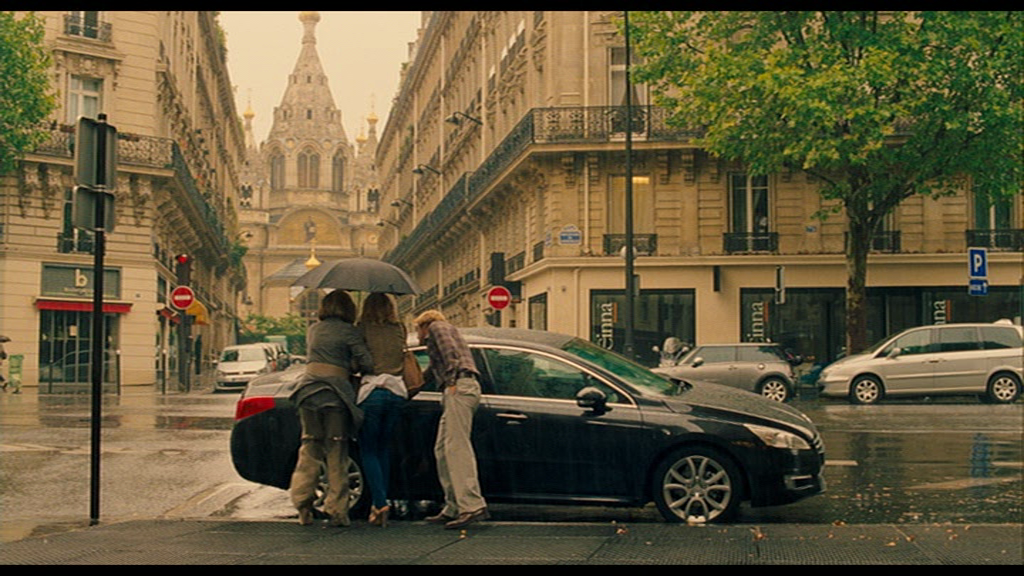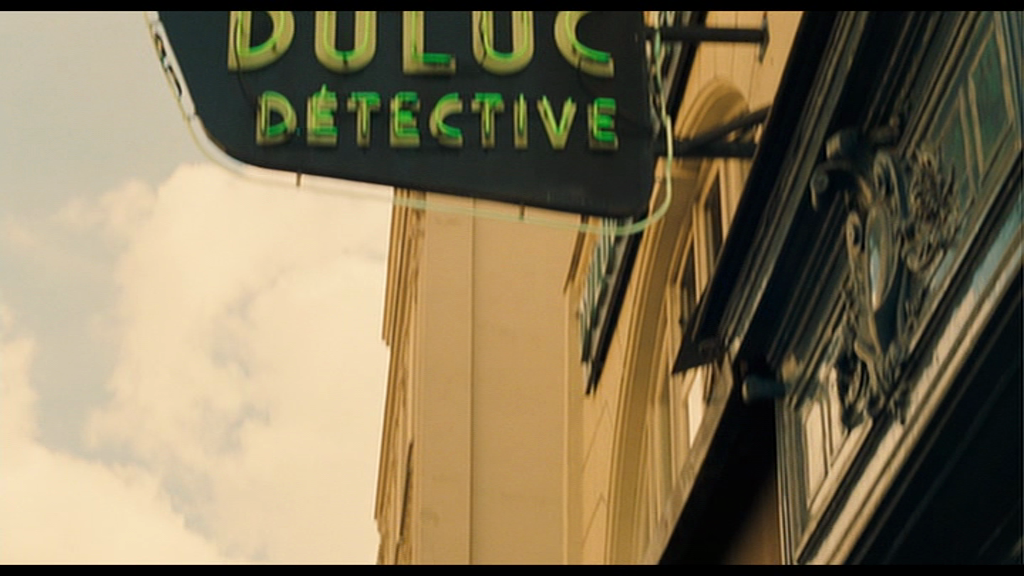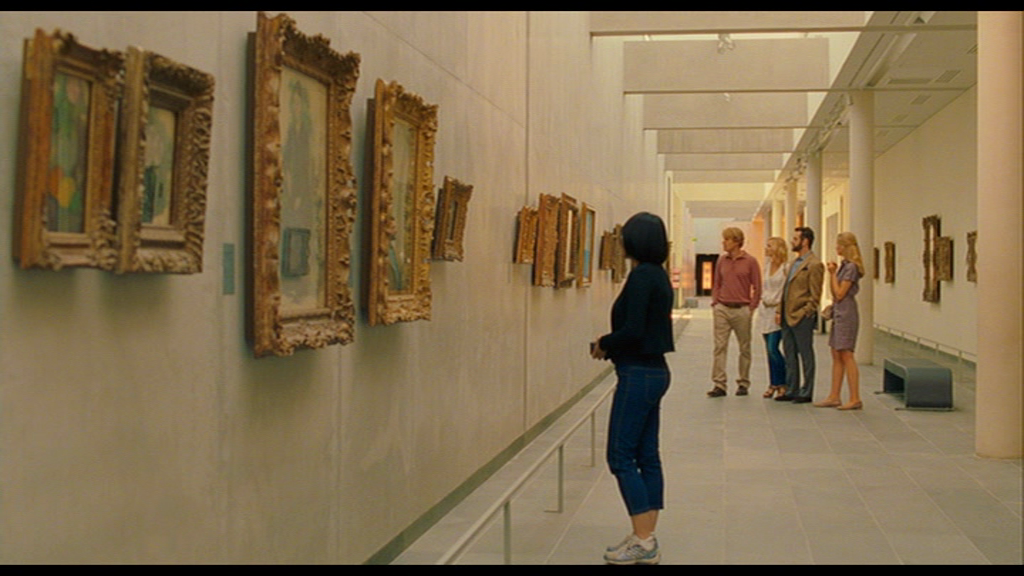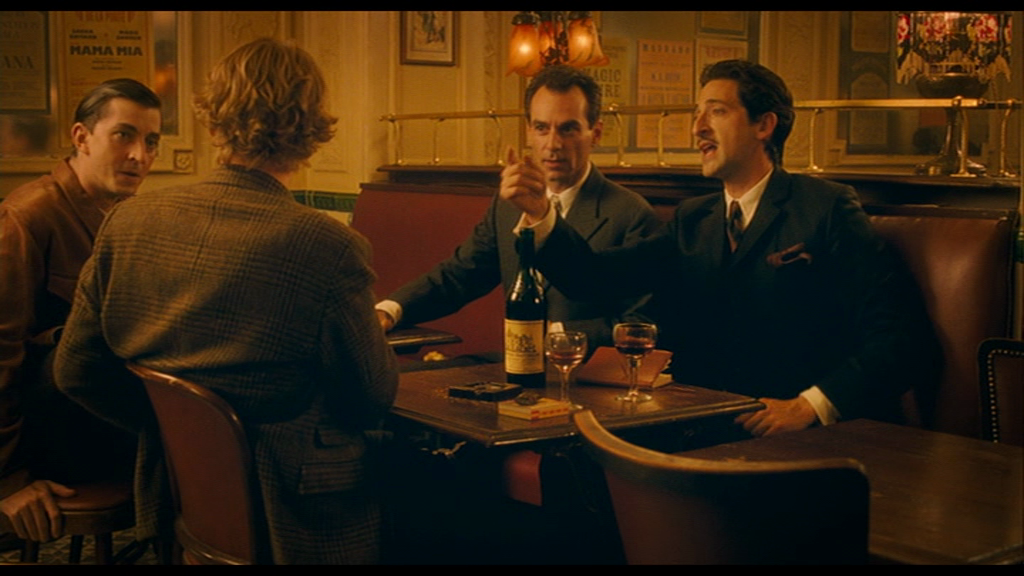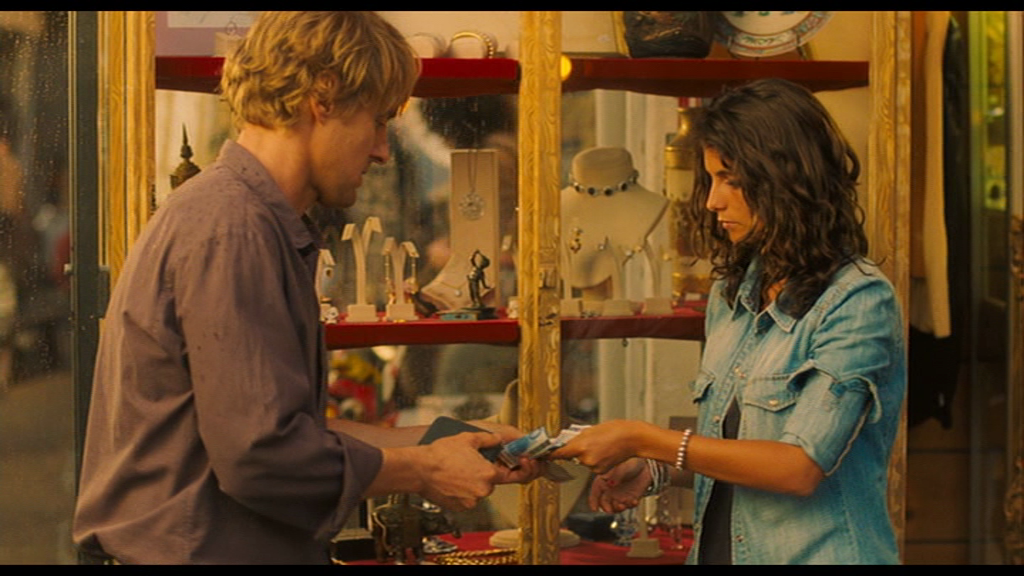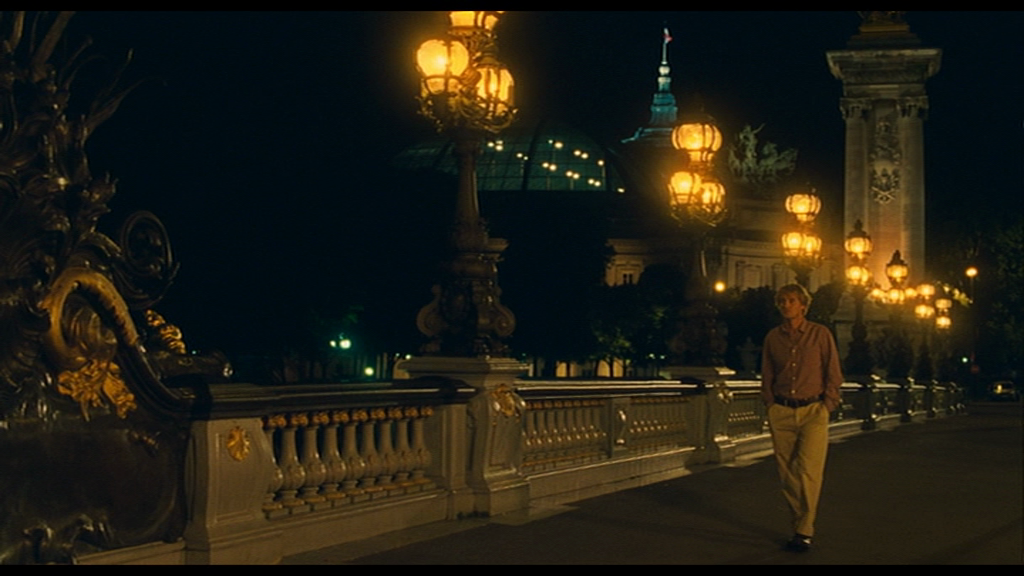an American tourist in Paris
Woody Allen's Midnight in Paris (2011) opens with a pre-credit montage of sixty views familiar to us from postcards, tourists' blogs and countless other cliché-ridden sentimental comedies. Arrondissements 3, 9, 10, 11, 12, 13, 14, 15, 17, 19 and 20 are all absent from this opening summary of the city's attractions, which concentrates instead on the central arrondissements, chiefly the eighth, with excursions to the sixteenth and of course to Montmartre, in the eighteenth:
This montage is not a random assortment. The half-way point is marked by a view of rooftops that, if characteristically Parisian, is not especially typical of the views tourists bring home with them:
The thirty preceding images had all shown Paris in bright sunlight. This sun-bathed rooftop view is followed by sixteen images of Paris in the rain, replacing the touristic norm with a different mode of the picturesque. Some of the images can be paired as different views of the same place and in different weather, as here, the place de la Concorde:
Or here, the place François 1er:
Or here, the Louvre:
Or here, the Arc de Triomphe:
The last eight of the 'Paris in the rain' images can be grouped together because they show the fifth and six arrondissements, which had barely featured among the first thirty images of the montage. This Left Bank group includes the one shot that is not static. A view across the boulevard Saint Germain begins looking down at the rain-soaked street and tilts up towards the UGC Danton cinema:
The 'Left Bank in the rain' group is followed by three sunny views of the parc Monceau (Right Bank), then the montage closes with ten views of Paris by night, all Right Bank or of bridges (so neither Left nor Right). Here again there are possible pairings with earlier images, different views of the same place, in different light:
The first image of the prologue was a daylight view of the Eiffel Tower and the pont Alexandre III, looking west. The last is a view, looking east, of the pont de Bir-Hakeim and the Eiffel Tower, illuminated - a closing cliché from the 'Paris by night' repertoire:
The tower and bridge motifs return in the film's closing sequence, with the protagonist, Gil, on the pont Alexandre III:
And the film ends by combining the 'Paris in the rain' and 'Paris by night' motifs in its closing shot:
Other images in the prologue sequence serve as a template for the topography of the film that follows, though not always as neatly. There is a view of the ferris wheel in the Tuileries Gardens that is echoed in a view of it from the top of the Hotel Le Meurice, on the rue de Rivoli:
A view of men playing boules in the gardens of the Palais Royal can be paired with a scene in the nearby Grand Véfour restaurant:
The rear view of Notre Dame is seen more closely when the protagonist meets Carla Bruni in the square Jean XXIII:
Standard views of the Sacré Coeur feature in the prologue and in the body of the film:
As do night-time views of the Pont-Neuf:
There are four views of the place Vendôme in the prologue and one later sequence is set there, in a jewellery shop and on the street outside:
A standard view in the prologue of the Moulin Rouge announces the sequence later where Gil meets Toulouse-Lautrec there, though that sequence uses Can Can dancers to situate us rather than a view of the exterior:
Any further topographical matches are not so exact, but in general we can say that the prologue announces a vision of Paris that the film rarely departs from. It leaves the city only to go on the standard tourist excursions to Giverny, Versailles and the Puces at Saint Ouen:
The film's principal location is the hotel where its tourists are staying - the Hotel Bristol at 112 rue du faubourg Saint Honoré, 8e, right in the middle of the arrondissement most seen in the prologue:
The plot has Gil deviate from the itinerary of his fellow travellers by visiting Paris in the 1920s. He does so from a starting point in the Latin Quarter, on the rue de la Montagne Sainte Geneviève, 5e, by the steps of Saint Etienne du Mont:
There is a marked difference between the film's approach to the topography of present-day Paris and how it configures Paris in the past. In the present day, there are no non-sequiturs of movement from one location to another. After the party on the roof of the Le Meurice Hotel the guests leave by that hotel's ground-floor exit:
After Gil buys a book on the quai de Montebello he finds himself, logically enough, in the gardens behind Notre Dame, just a little further along:
And near the end, after being at the terrace of a café on the quai de la Tournelle, the next shot shows him a little further down, coming out of the Shakespeare and Company bookshop:
It is true that, when walking around the Latin Quarter at night, Gil turns into the rue Pascal from the square Saint Médard, heading south, but in the next shot is seen somewhat to the north, coming down into the rue de la Montagne Sainte Geneviève from the rue Saint Etienne du Mont:
But these two shots are linked by a dissolve, so we can conjecture that he has been wandering lost in the area, for some time.
In the second shot he is already in a alternate version of Paris, since those lamps fixed to the wall of the rue Saint Etienne du Mont were added by the production - Paris is sometimes just not picturesque enough.
In the second shot he is already in a alternate version of Paris, since those lamps fixed to the wall of the rue Saint Etienne du Mont were added by the production - Paris is sometimes just not picturesque enough.
|
This is the moment when he takes his journey back to 1920s' Paris, the topography of which is full of non-sequiturs.
For example, the protagonist is taken to Bricktop's nightclub, but they go to an address on the rue Malebranche, 5e, rather than to its actual location, at the junction of the rue and place Pigalle, 9e: |
Depending on when exactly in the 1920s we are supposed to be, Bricktop's establishment was here, at 66 rue Pigalle, or further down the street at Le Grand Duc. The actual location in the photograph above wasn't an option for Midnight in Paris, since this is what the place looks like now:
But the buildings of other Pigalle clubs where Bricktop worked are still intact, such as Chez Florence at 61 rue Blanche and La Grand Duc at 52 rue Pigalle:
Allen's decision not to situate Bricktop's in Pigalle is all the more curious in that a later sequence has Gil walking up the next street along into the place Pigalle:
This represents the corner of the rue Duperré and the place Pigalle, though I think it is a reconstruction in the studio.
There is no doubting that Allen knows that Bricktop's was in Pigalle, since he paid homage to Bricktop herself when he featured her in Zelig (1983), one of his earlier excursions to Paris:
There is no doubting that Allen knows that Bricktop's was in Pigalle, since he paid homage to Bricktop herself when he featured her in Zelig (1983), one of his earlier excursions to Paris:
For more about Bricktop in Paris, see Tyler Stovall's Paris noir: African Americans in the City of Light (Boston: Houghton Mifflin, 1996).
1
Josephine Baker, who can be seen at Allen's version of Bricktop's, also appeared with him in Zelig:
1
Josephine Baker, who can be seen at Allen's version of Bricktop's, also appeared with him in Zelig:
This interior is the Laperouse restaurant, quai des Grands Augustins, 6e.
Almost every part of 1920s Paris visited by Allen in 2011 is a composite or confection. After Bricktop's, Gil meets Hemingway at the Polidor, 41 rue Monsieur le Prince, 6e:
But when he wants to go back there again he finds that it has gone, replaced by a modern launderette:
Since the actual Polidor is still there on the rue Monsieur le Prince, the film substitutes for it a launderette in a street some distance away, at 16 rue des Patriarches, 5e:
Gil visits Gertrude Stein, whose Paris address was 27 rue de Fleurus, 6e. The exterior used in the film is not that of this house - it doesn't have the commemorative plaque, and the door is not the right shape - but I haven't been able to identify where this actually is:
A fairground party scene is shot in the wonderful Musée des Arts Forains, occupying part of the old wine warehouses at Bercy, avenue des Terroirs de France, 12e:
When Gil leaves the party, however, he is not in the avenue des Terroirs de France but on the île de la Cité, in the place Dauphine, 1e:
In a later sequence he finds himself in the place Dauphine again, straight after leaving a party at the Maison Deyrolle, a museum of taxidermy on the rue du Bac, 6e:
The earlier view of the place Dauphine was the starting point of a topographically unfeasible walk through Paris that takes us from the île de la Cité to the butte Montmartre then, approaching it from the wrong direction, the place Pigalle then back to the île de la Cité:
Other parts of 1920s Paris are not topographically compromised. I include them here, alongside other parts of present-day Paris, for the sake of completism.
The party at which Gil meets Scott and Zelda Fitzgerald is at 53 quai du Bourbon, 4e:
The party at which Gil meets Scott and Zelda Fitzgerald is at 53 quai du Bourbon, 4e:
When Gil goes to Maxim's, rue Royale, 8e, that appears to be actually Maxim's, and not a reconstruction:
Of present-day Paris we see an antiques shop at 112 boulevard de Courcelles, 17e, with across the street a view of the Russian Orthodox church, rue Daru, 8e:
We see a detective agency on the rue du Louvre, 1e:
The gardens of the Musée Rodin, rue de Varennes, 7e:
And the interior of the Musée de l'Orangerie, 1e:
There is one other place I haven't located, the interior of this bar:
I'd appreciate any suggestions as to where this is: here.
Update: I had previously posted that I wanted to know where Gil buys earrings, but I realise now that this is the Puces at Saint Ouen again:
Update: I had previously posted that I wanted to know where Gil buys earrings, but I realise now that this is the Puces at Saint Ouen again:
Aside from the interesting difference in how it represents the past and present of the city (which was my reason for making this post), Midnight in Paris is an ordinary film. It is no worse, mind, than most other tourist films made in Paris (watch The Truth About Charlie if you want a really bad example). Woody Allen is just one of many visitor filmmakers who, though they came to pay homage to a place they loved, failed to show anything new, different or even real of that place.
In truth, I don't think there was any desire to be different. Tourist cinema travels in order to confirm the authenticity of the pre-formed image it already had of its destination. Midnight in Paris does that very well.
In truth, I don't think there was any desire to be different. Tourist cinema travels in order to confirm the authenticity of the pre-formed image it already had of its destination. Midnight in Paris does that very well.
My thanks to Dinora de Rivera y Mendoza, who has helped me get some of these identifications right.
Several sites are devoted to identifying the locations used for this film, and I am indebted to some of them.
Several sites are devoted to identifying the locations used for this film, and I am indebted to some of them.
